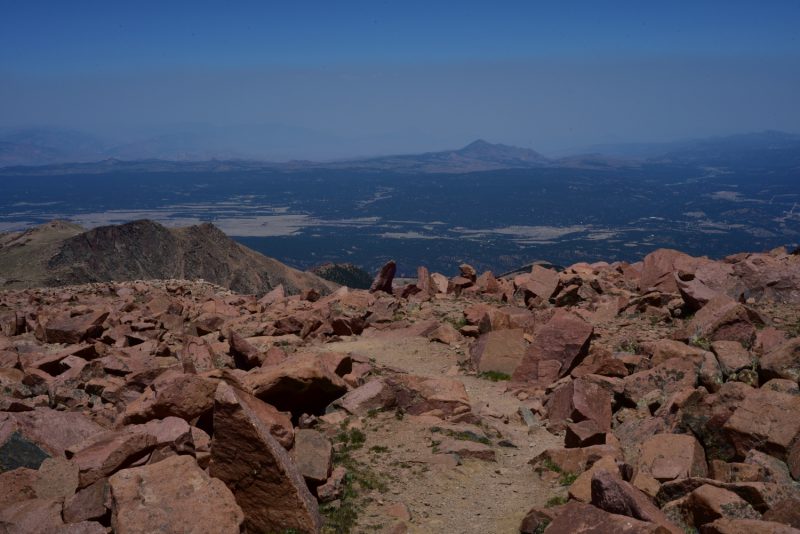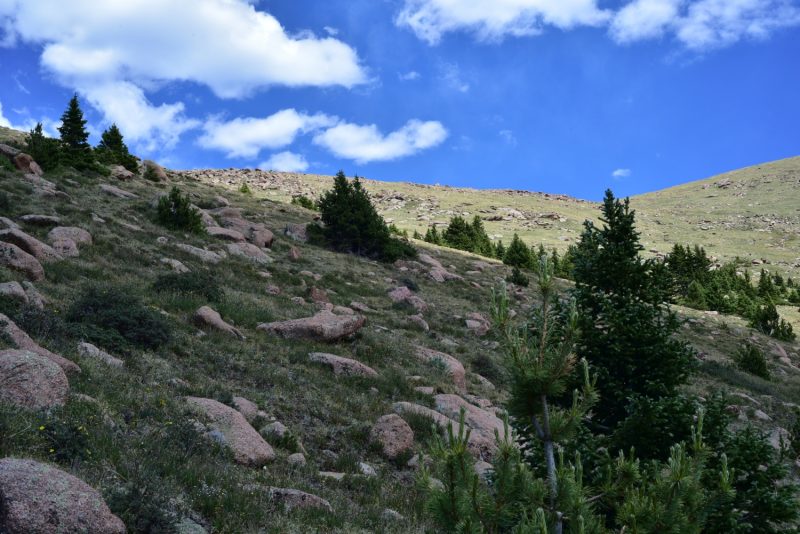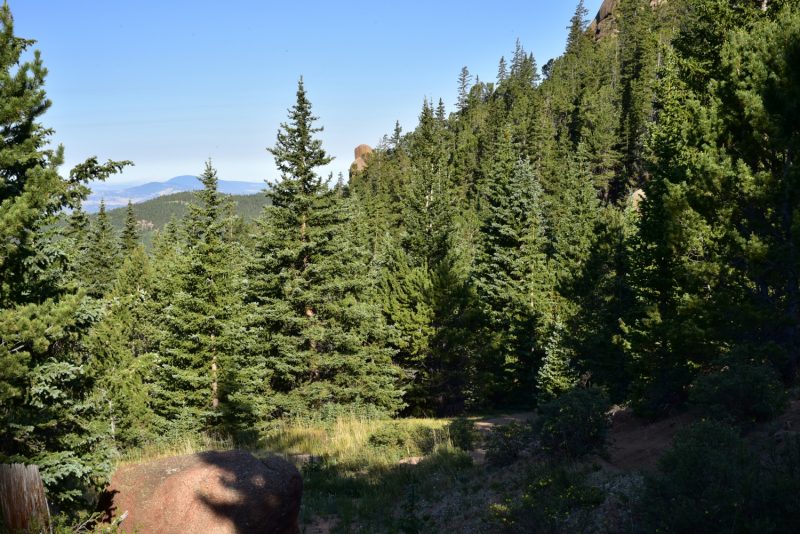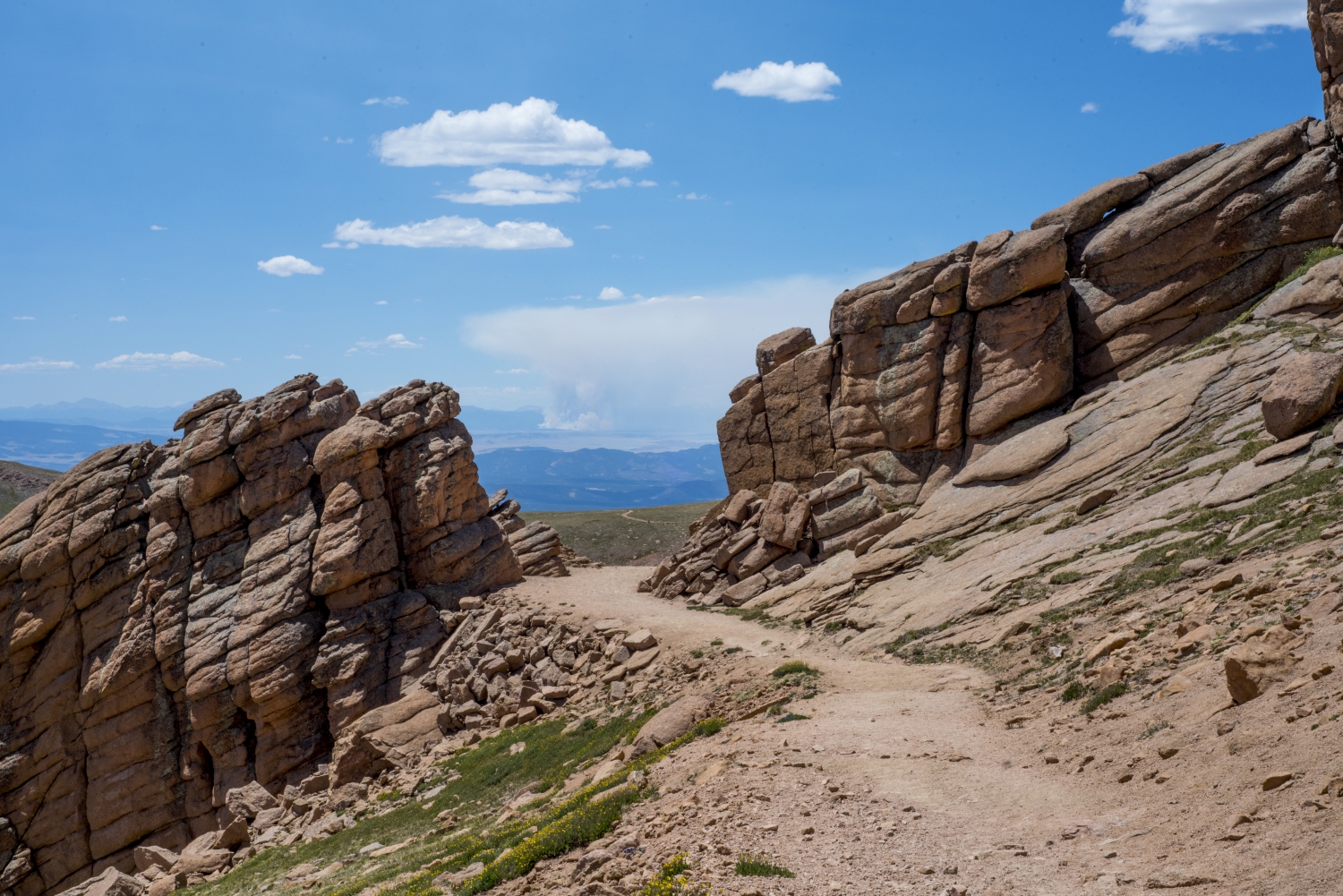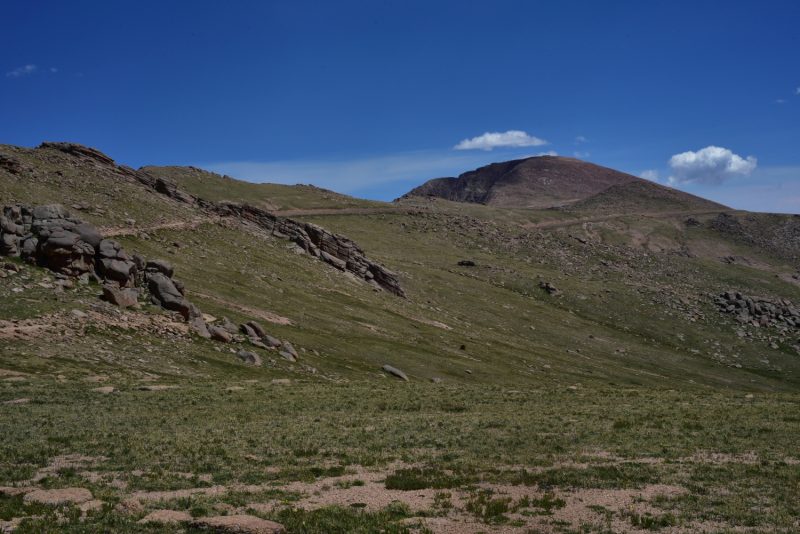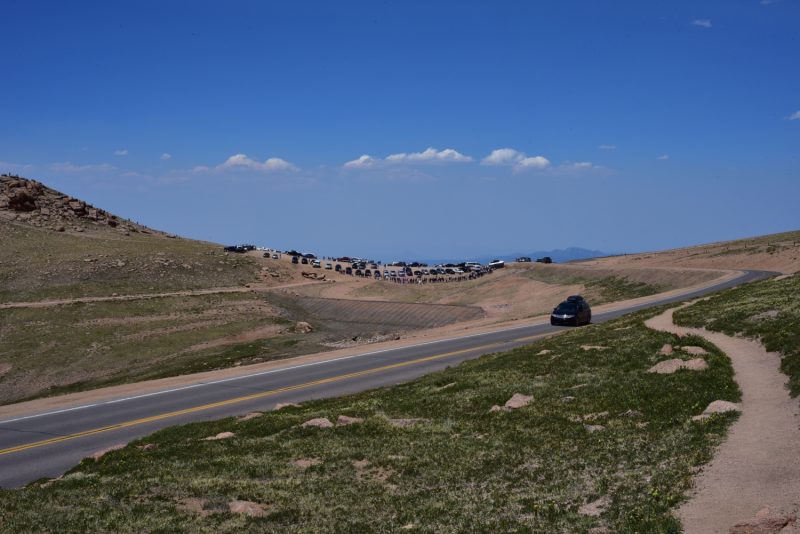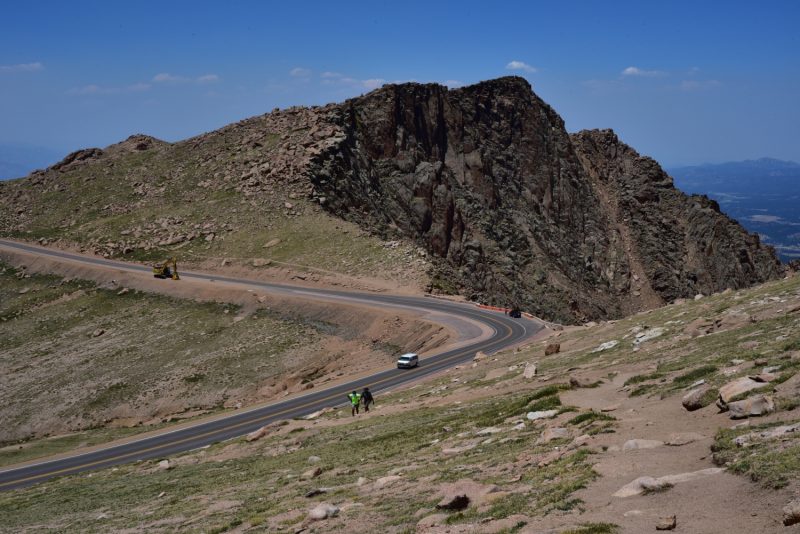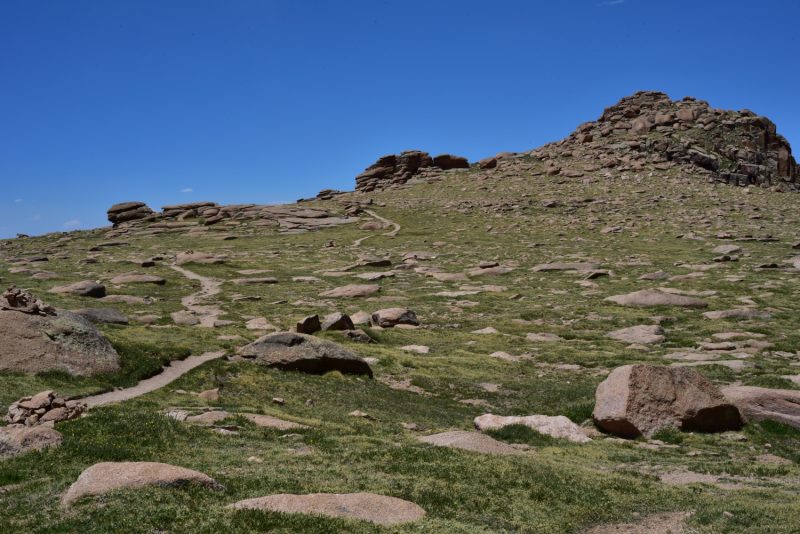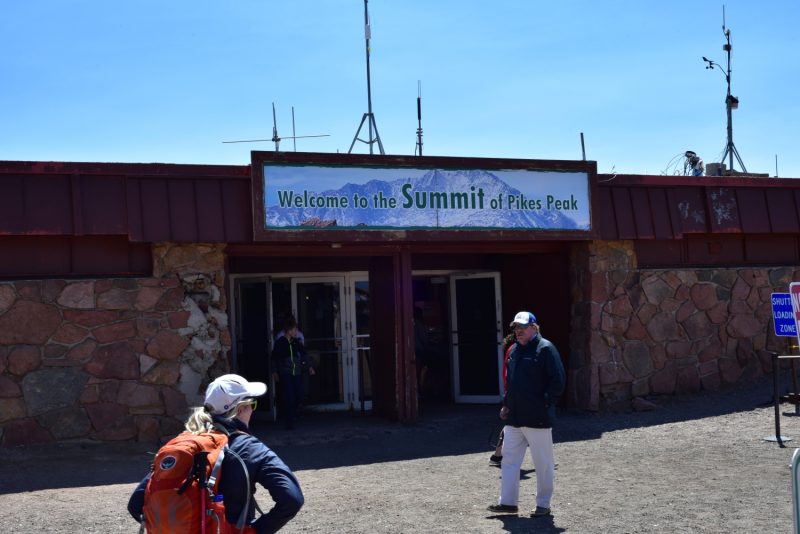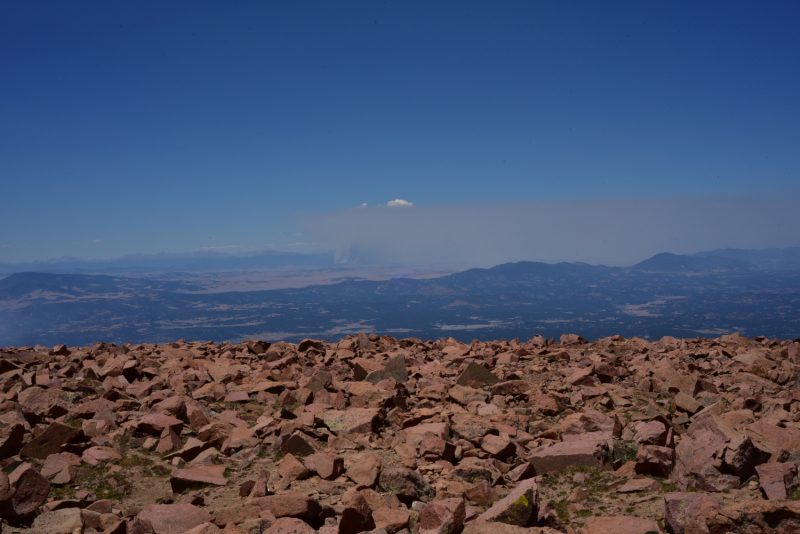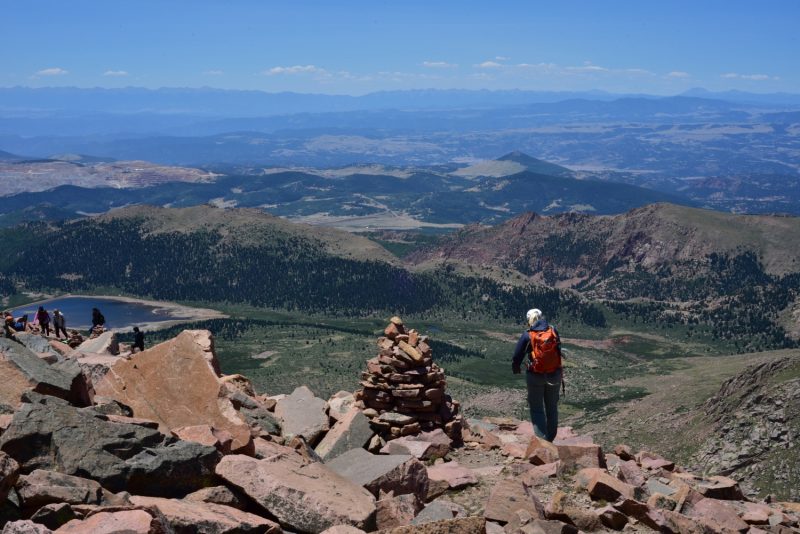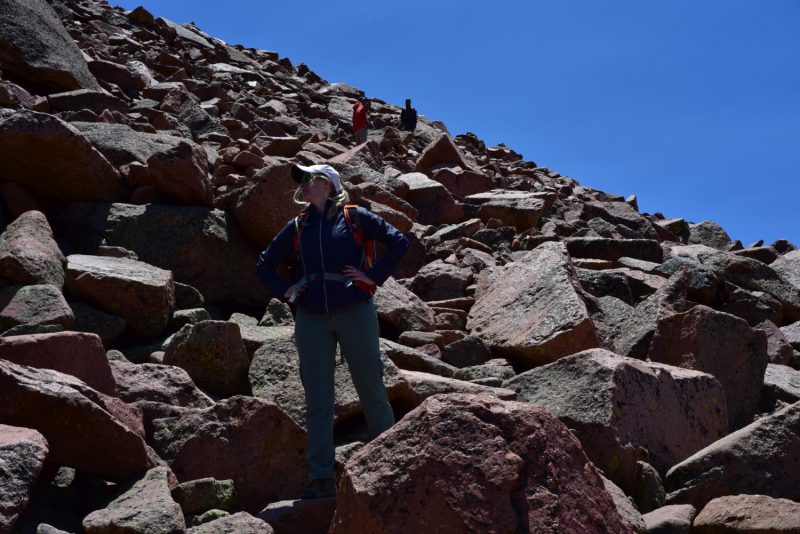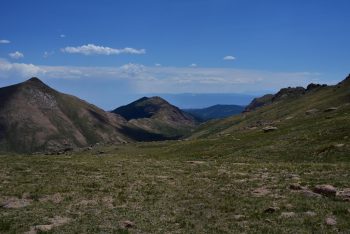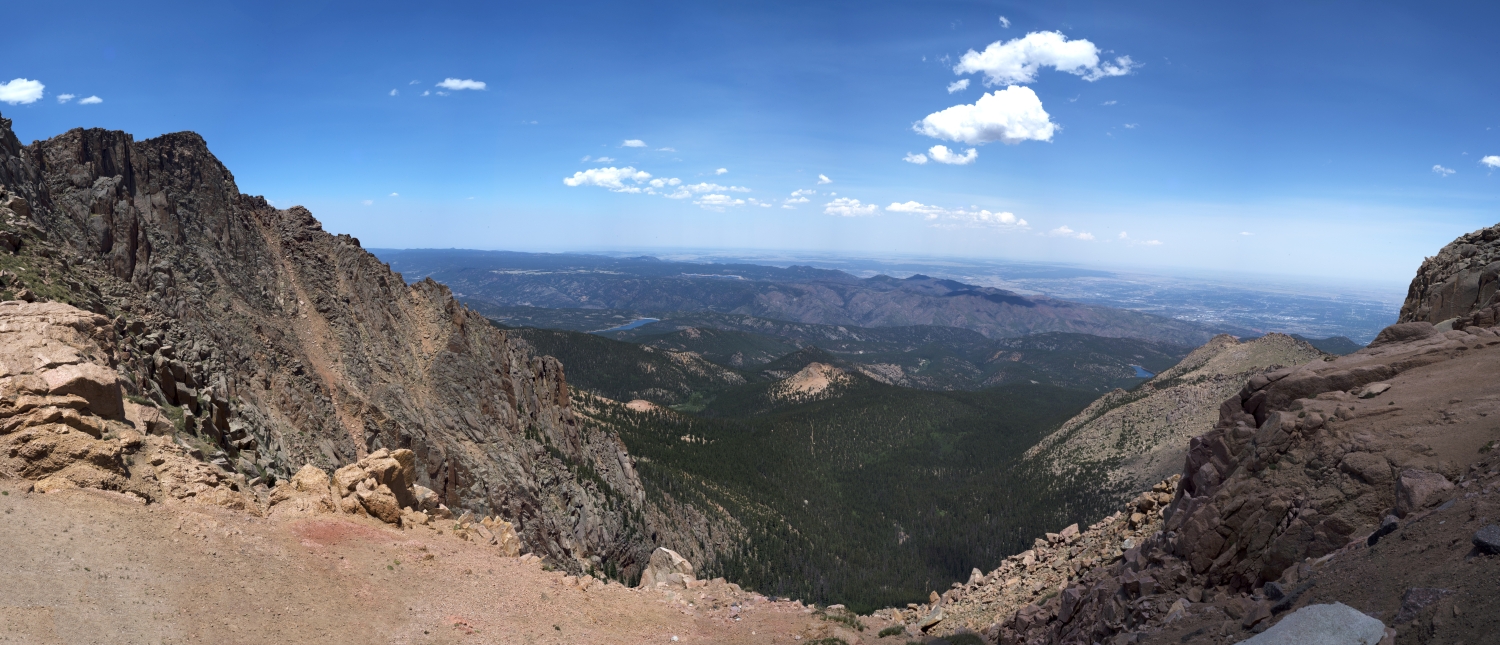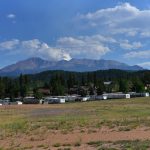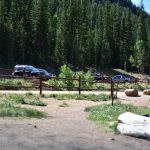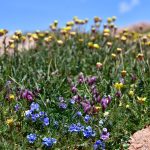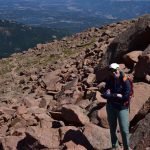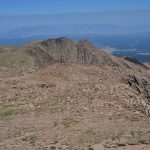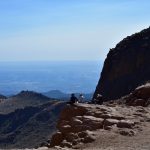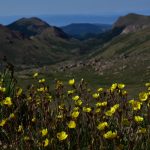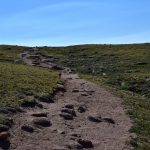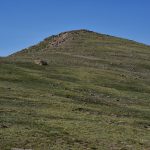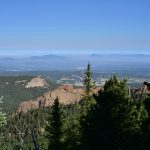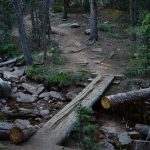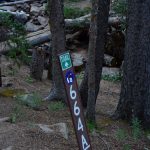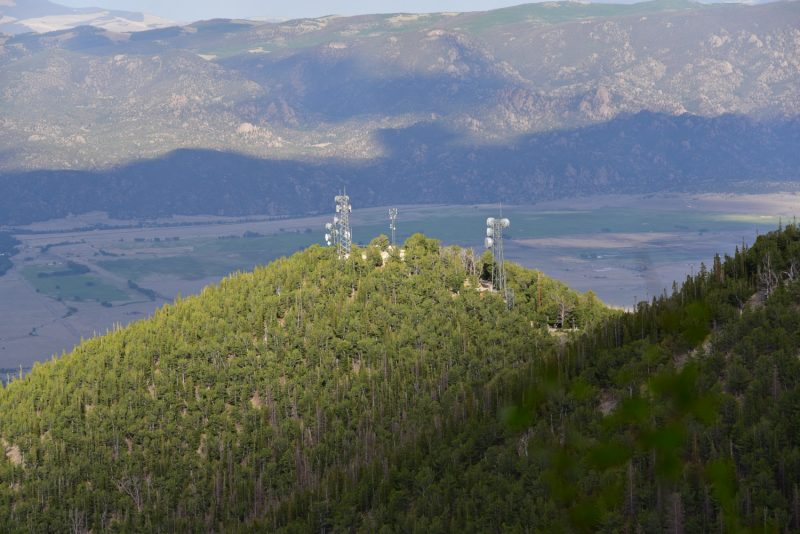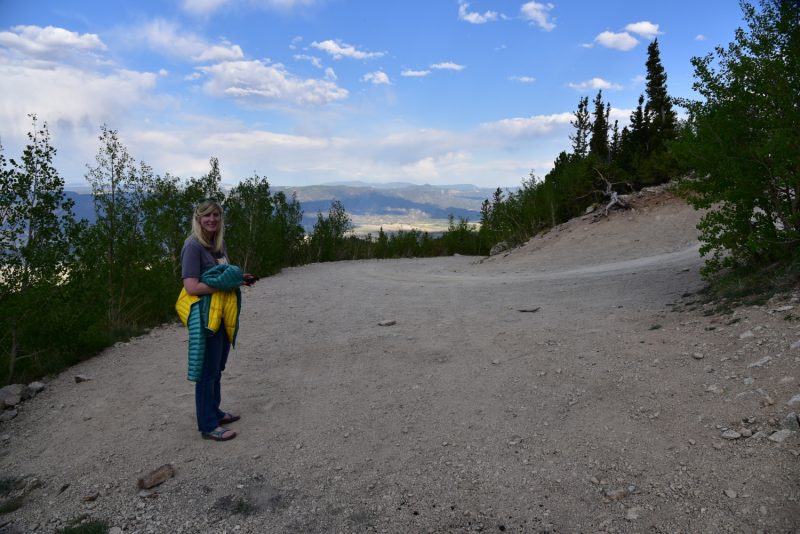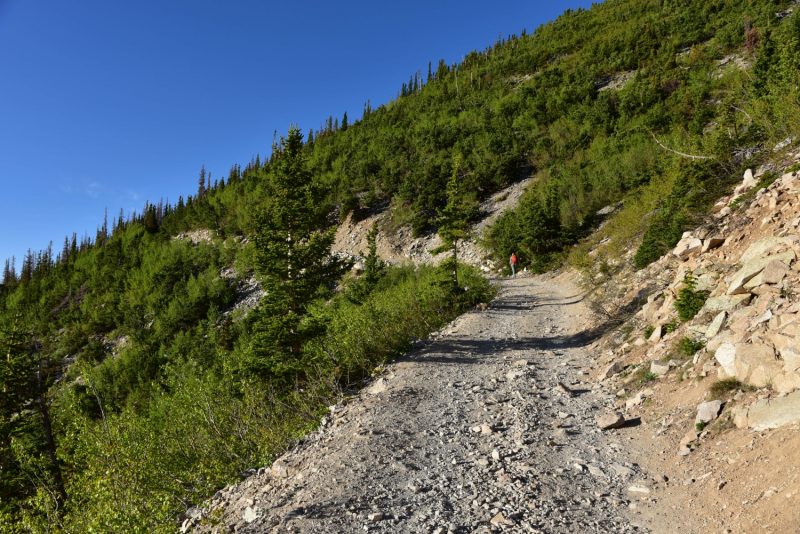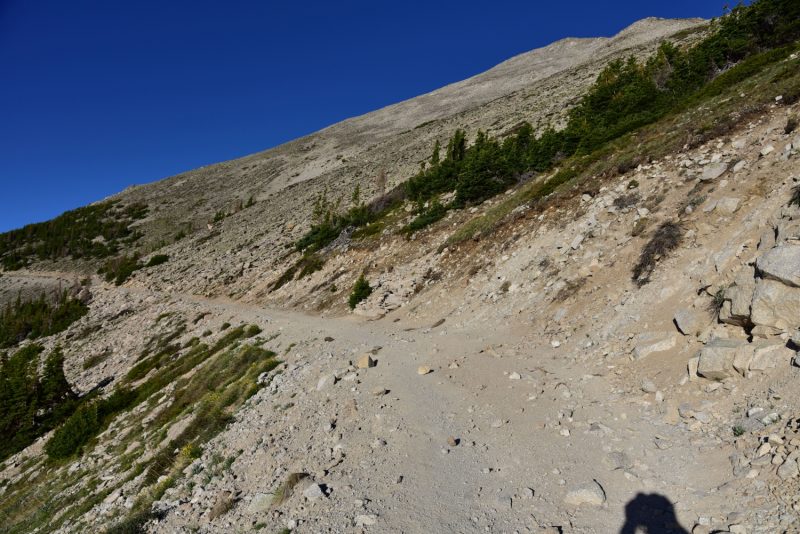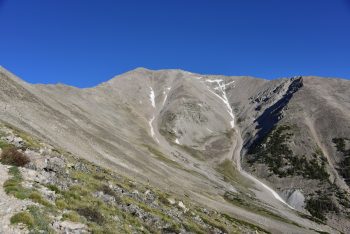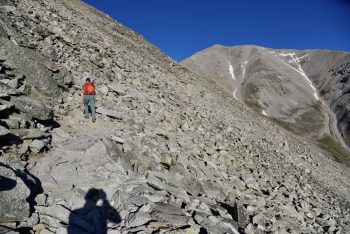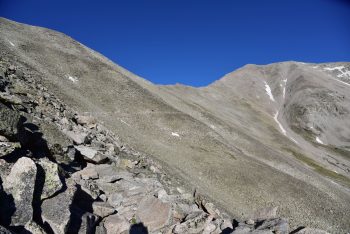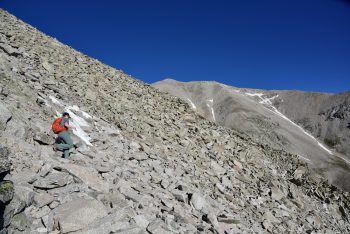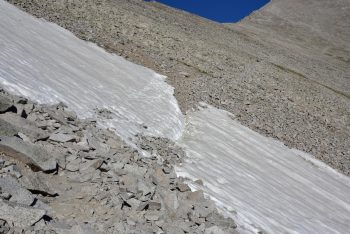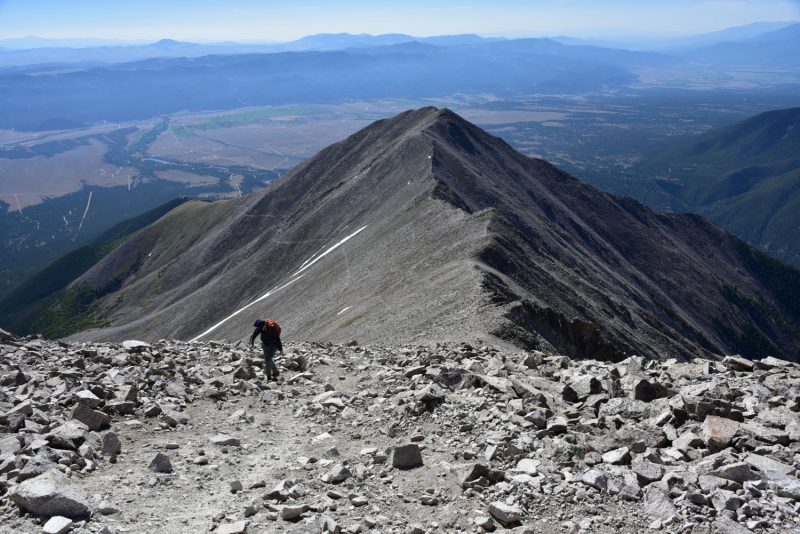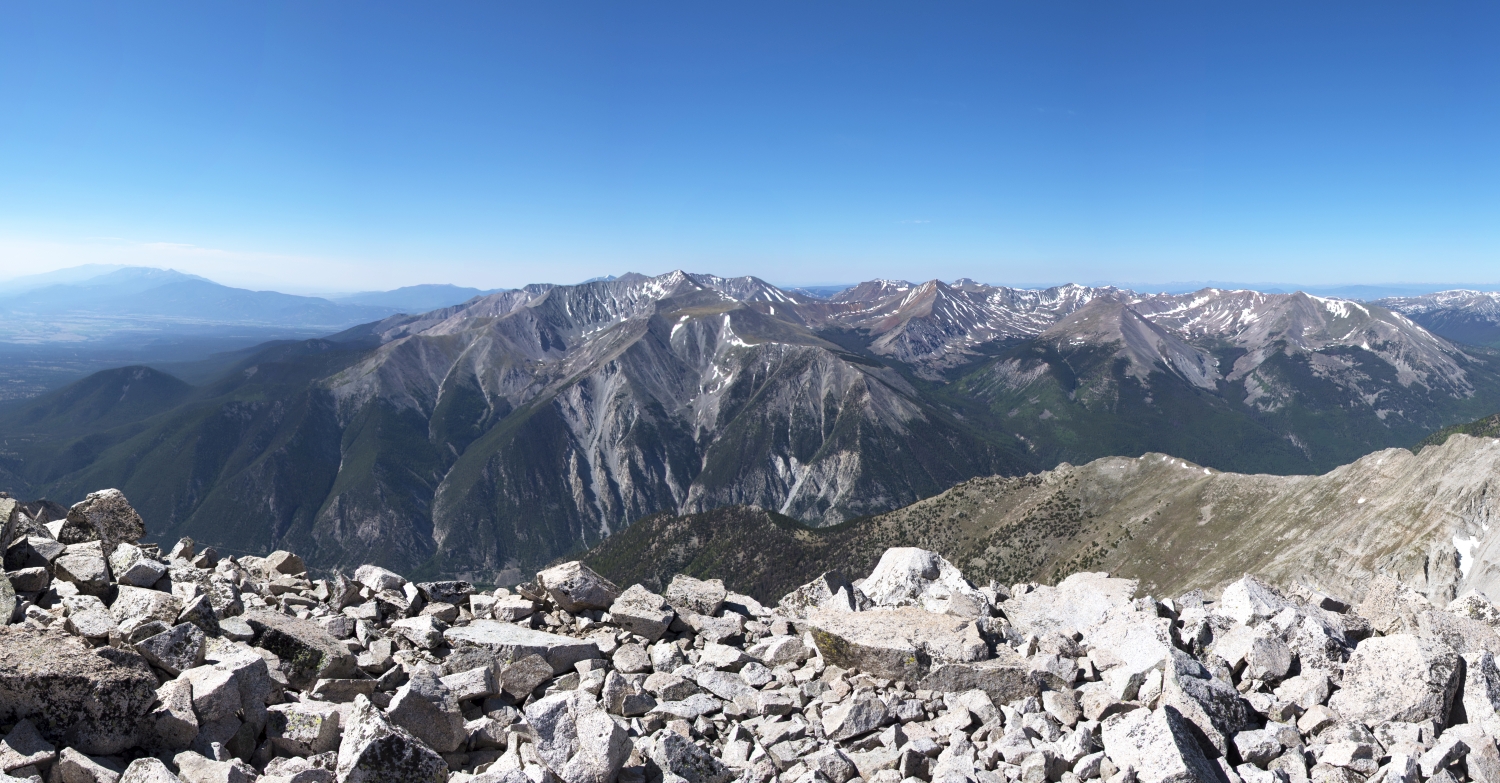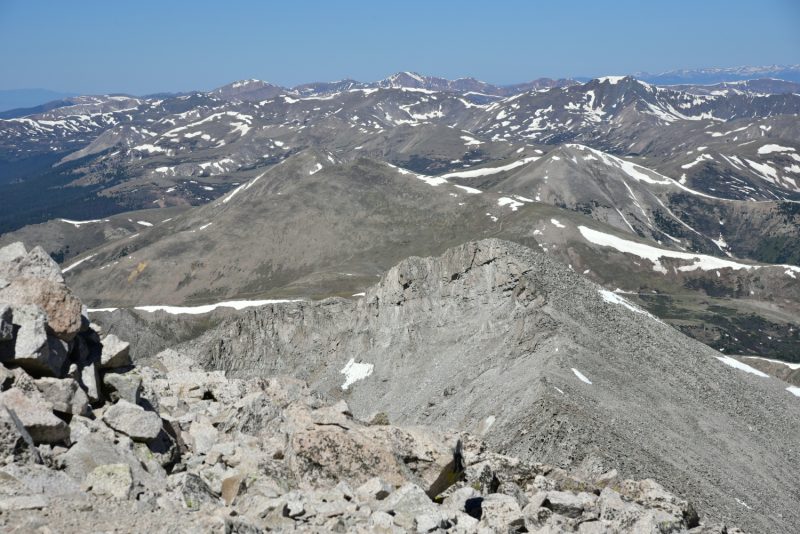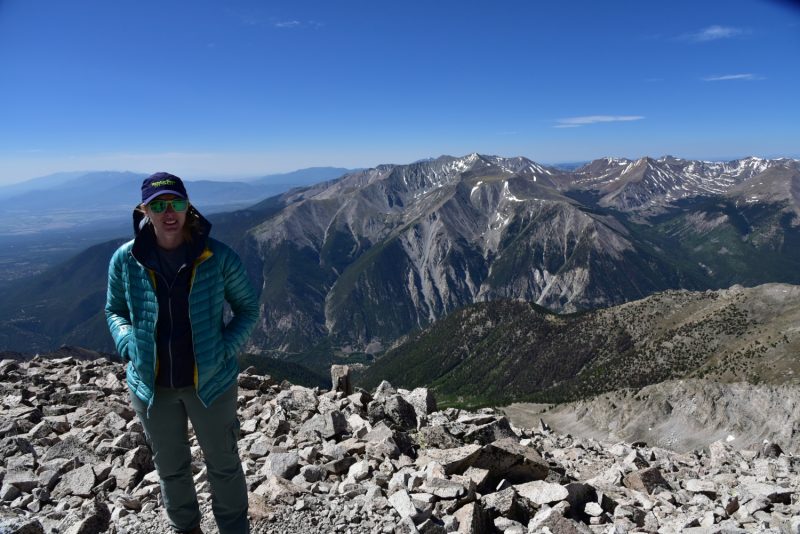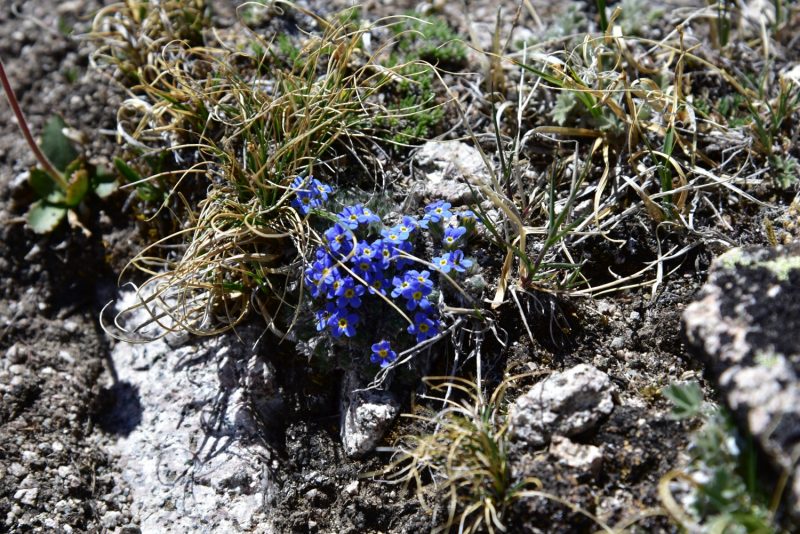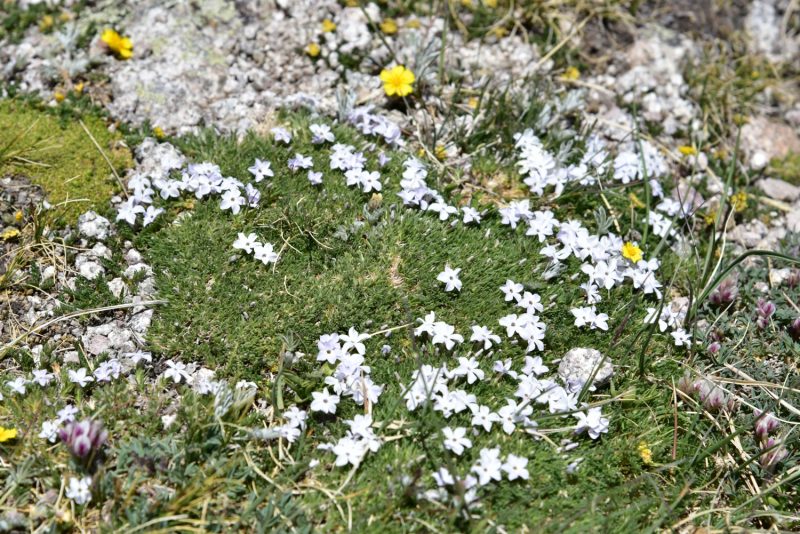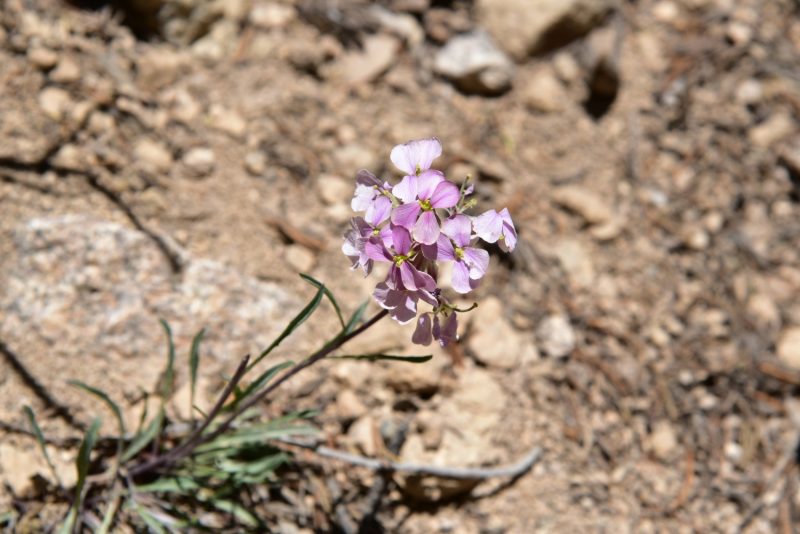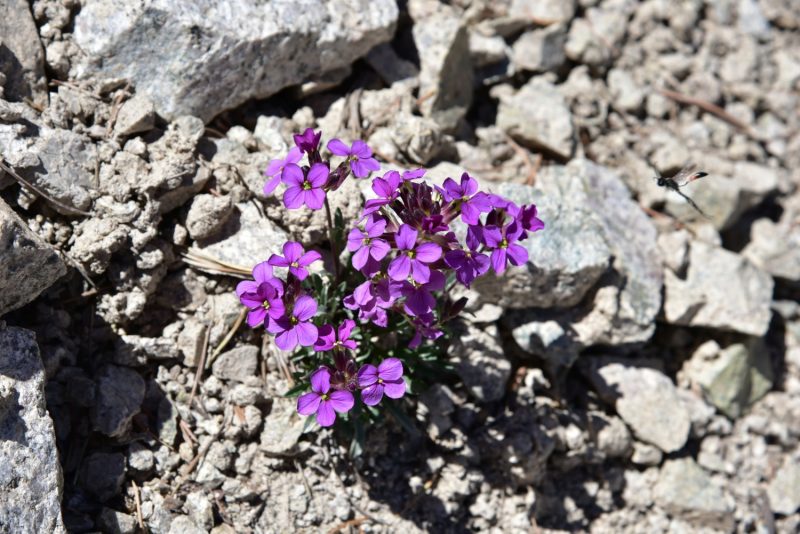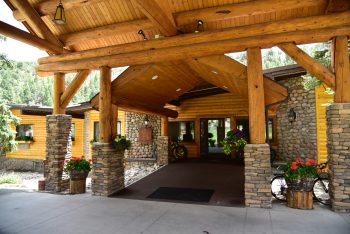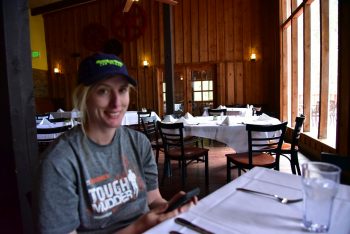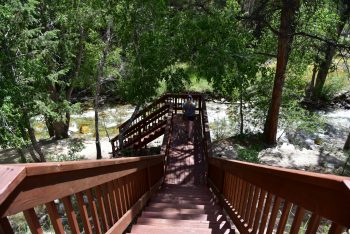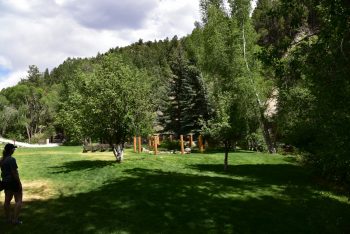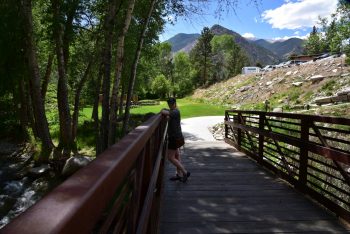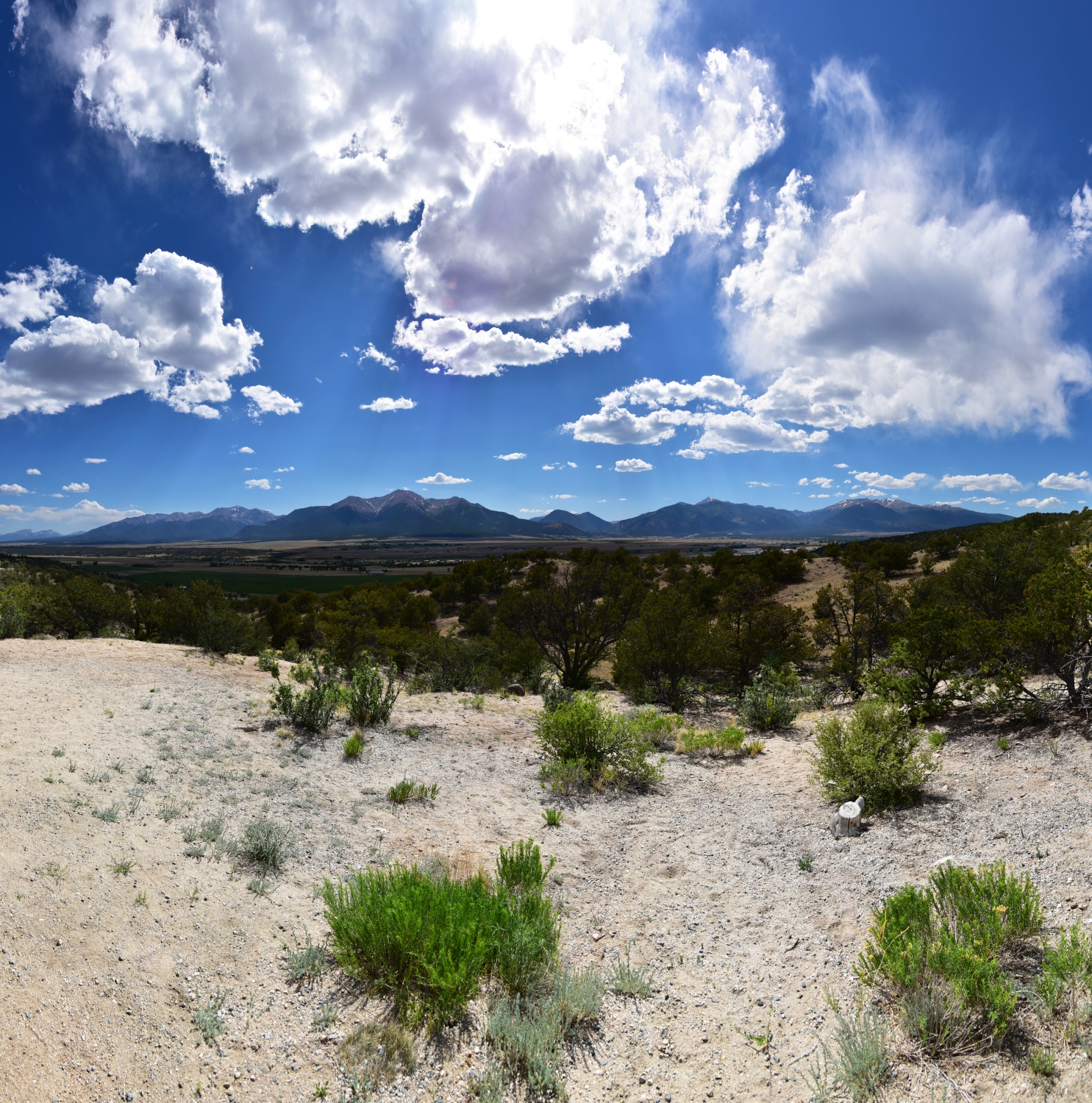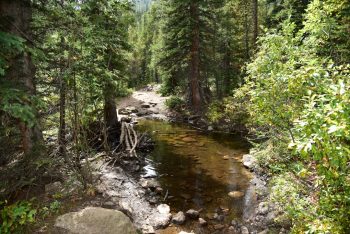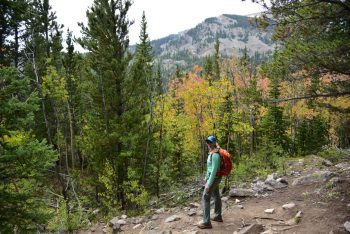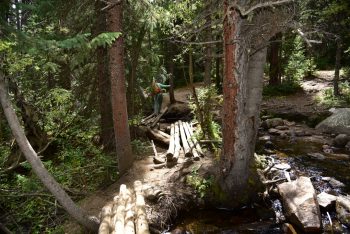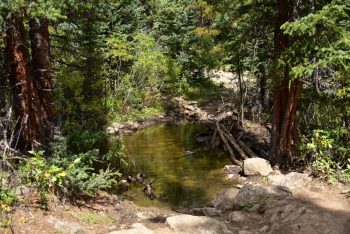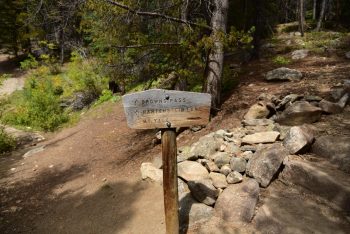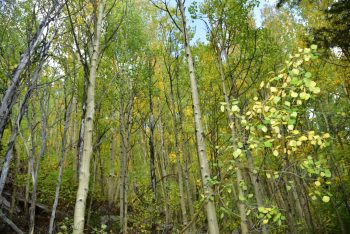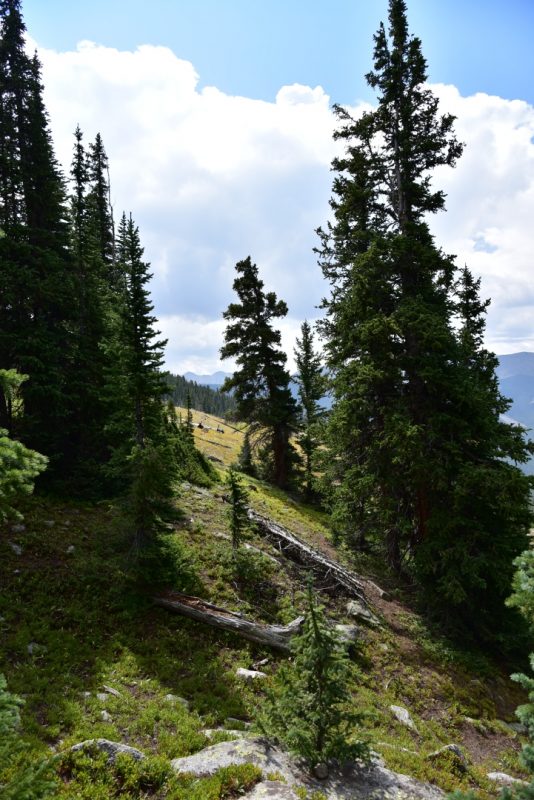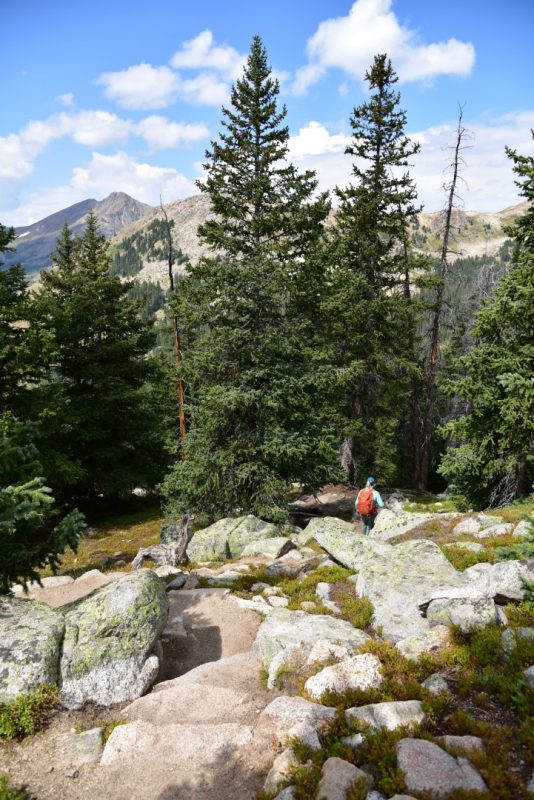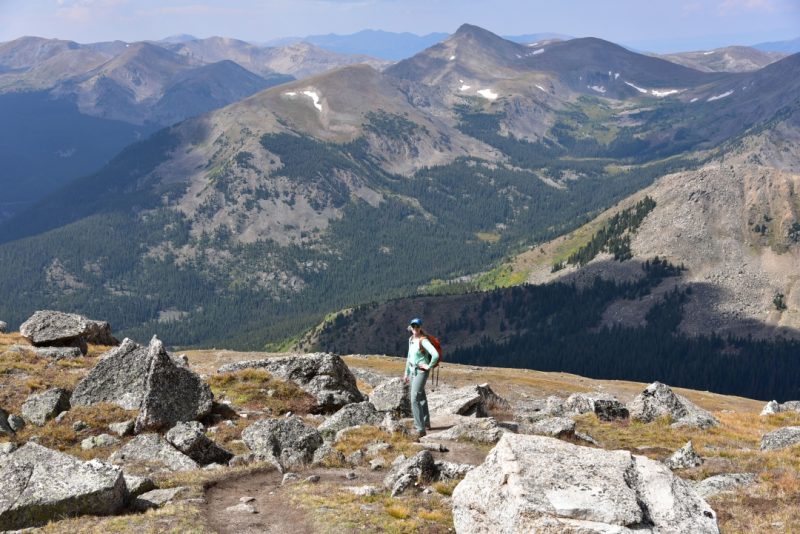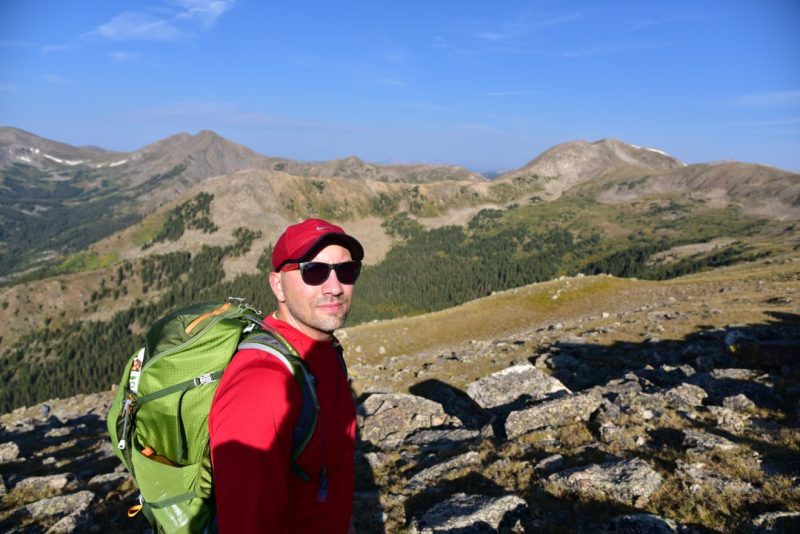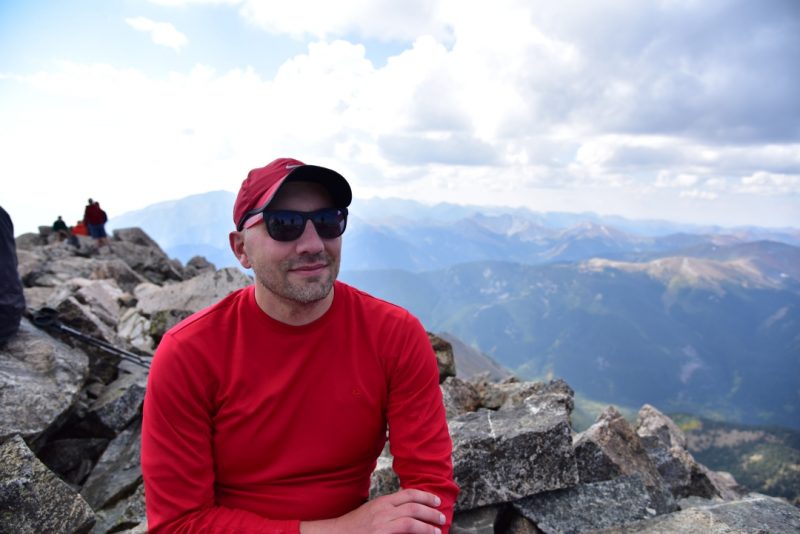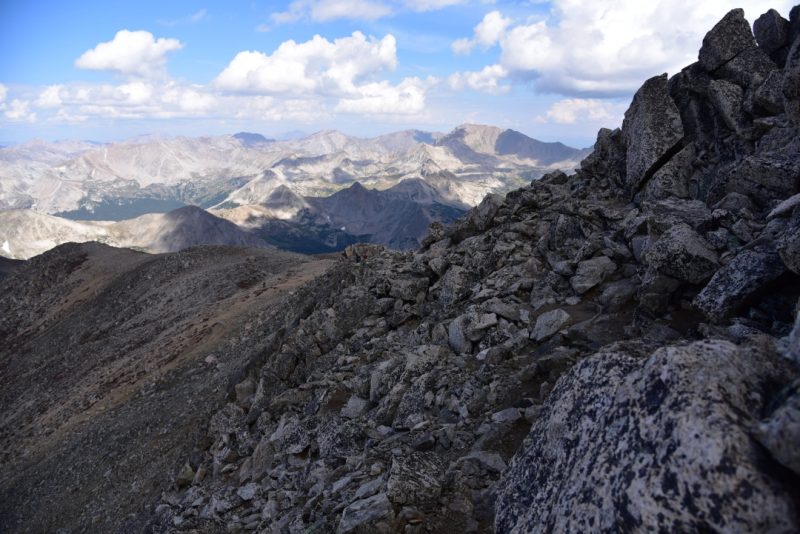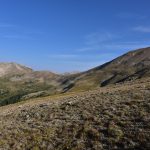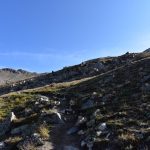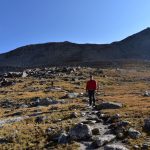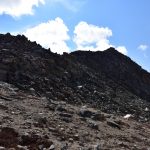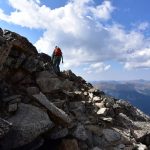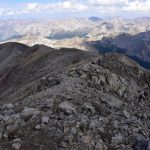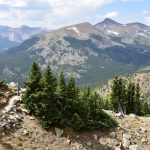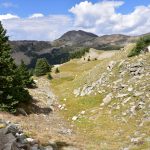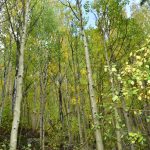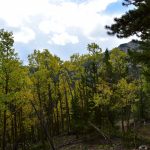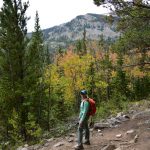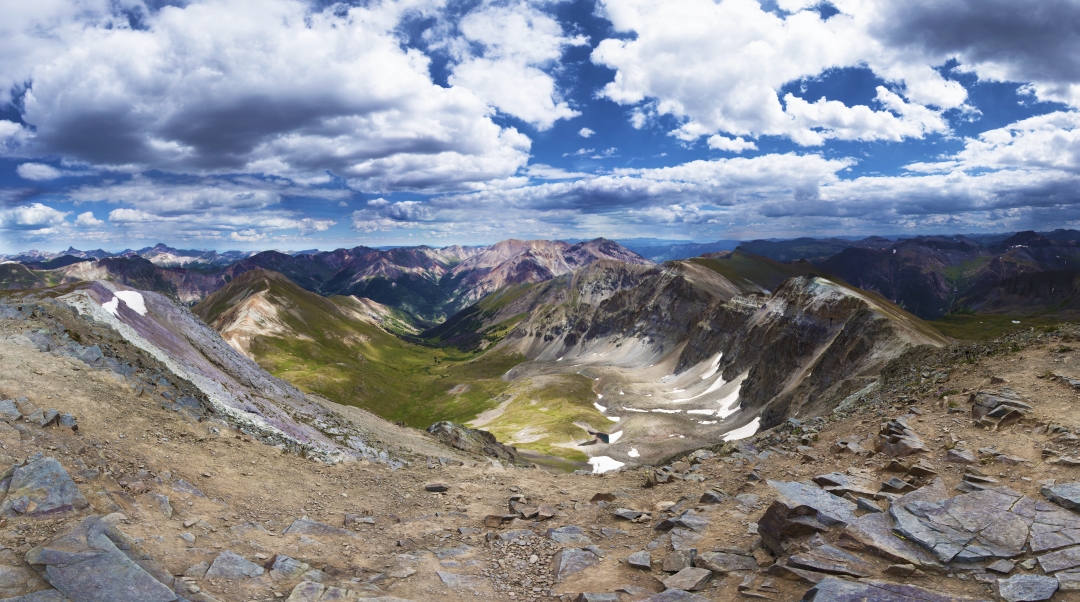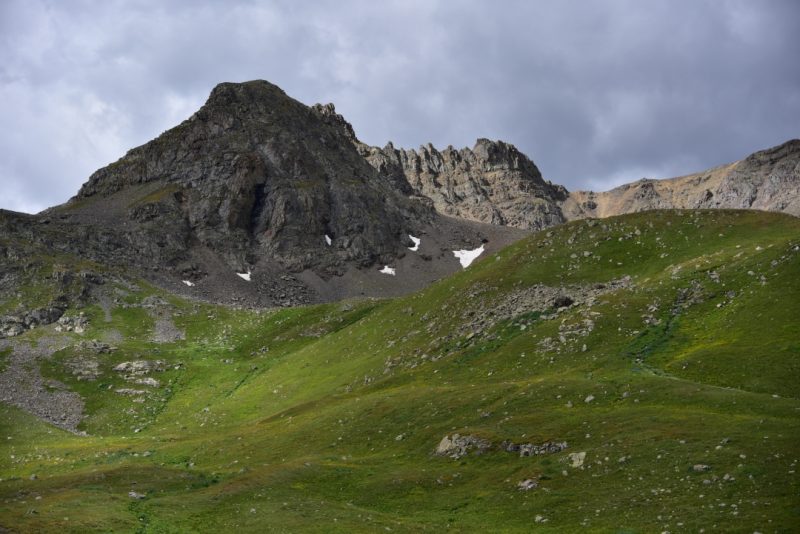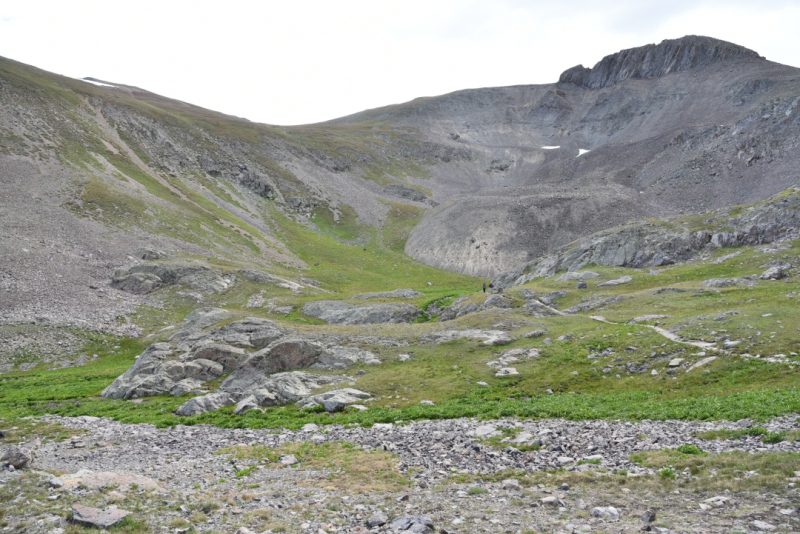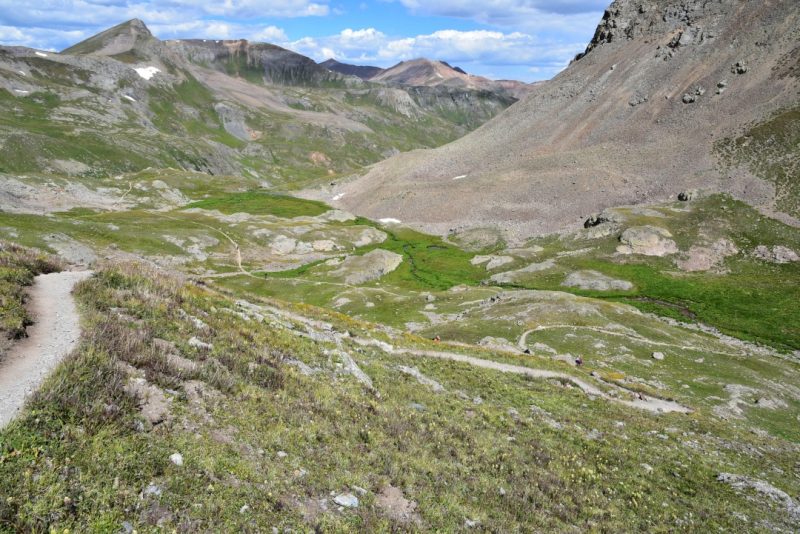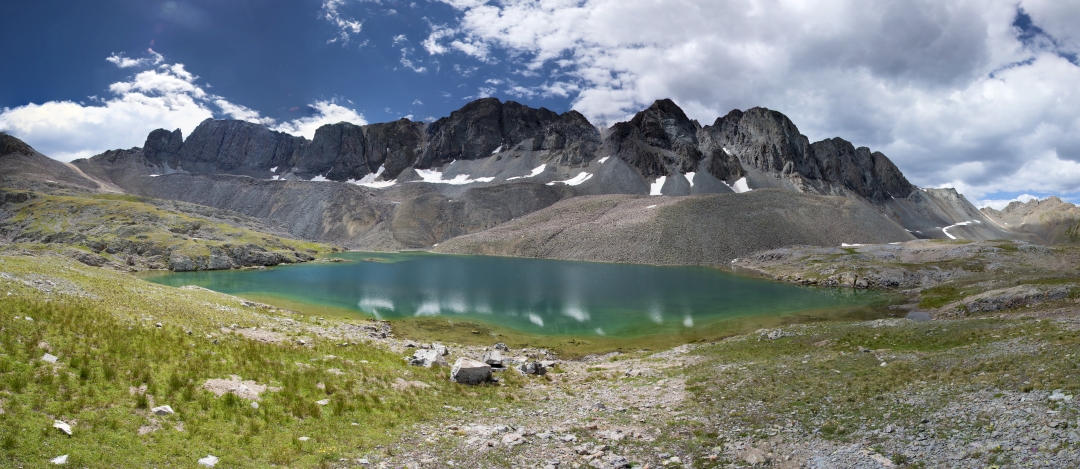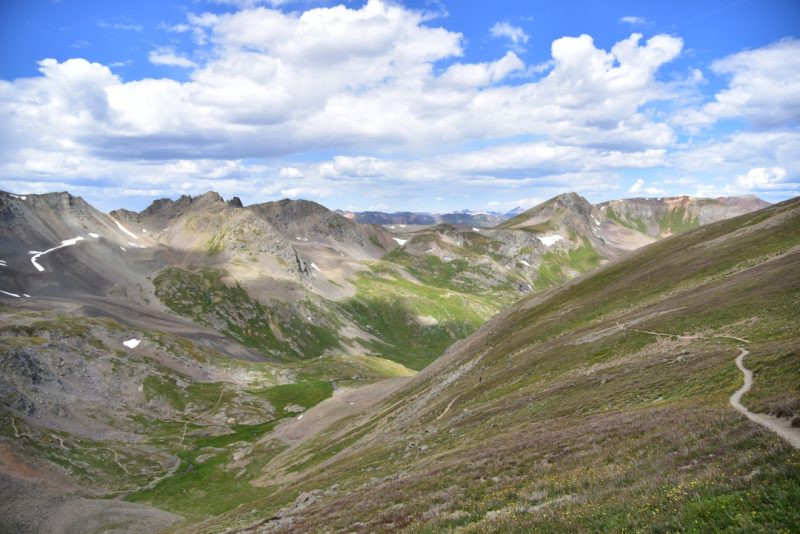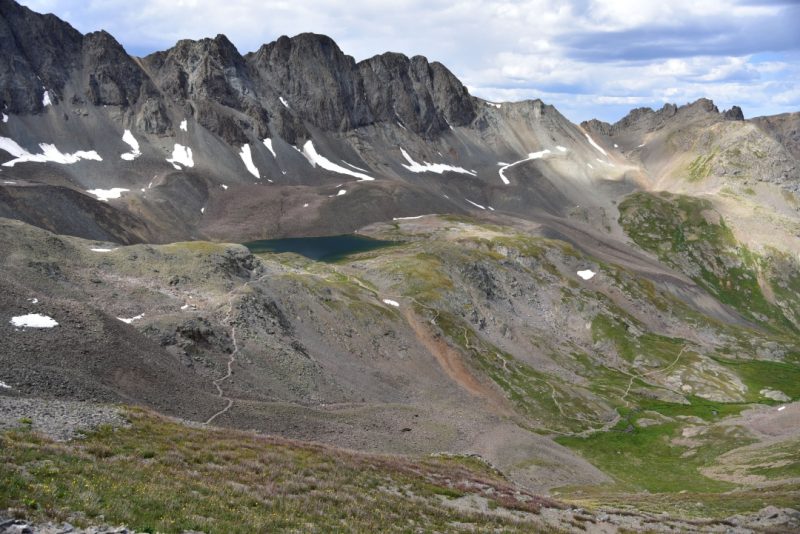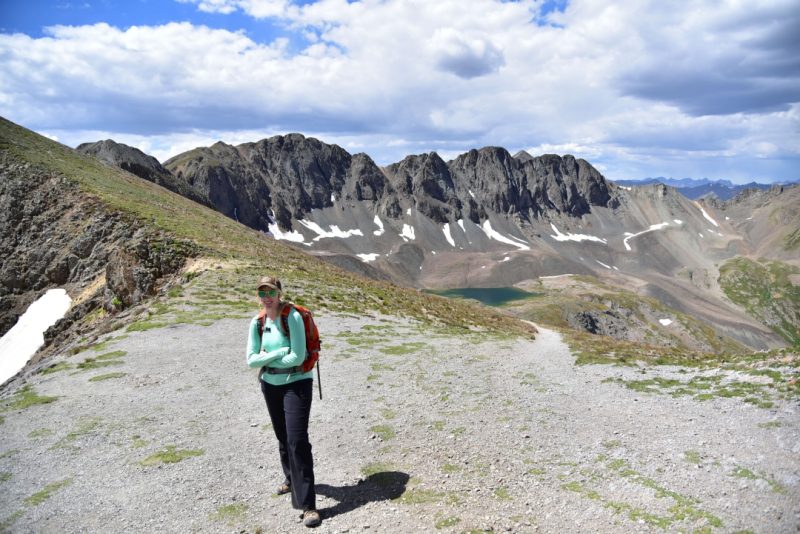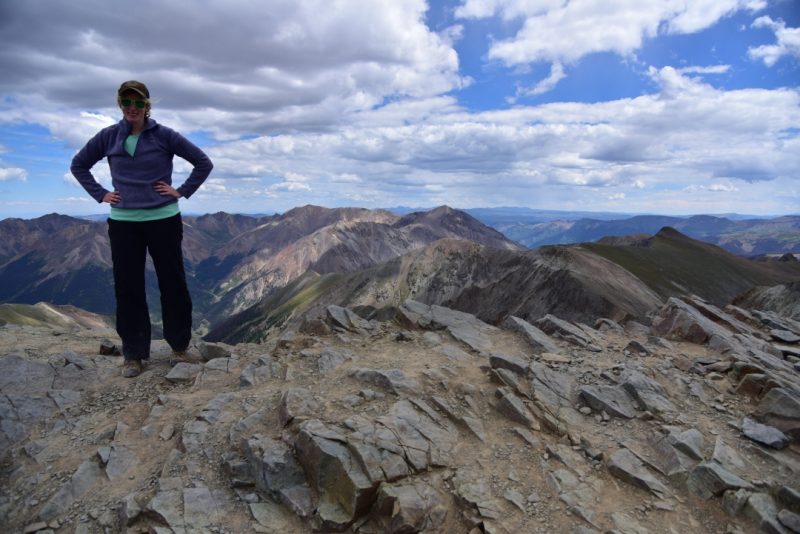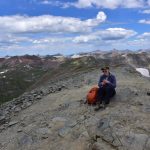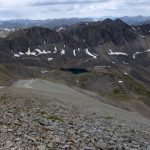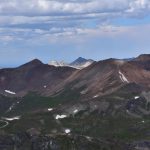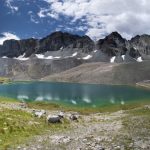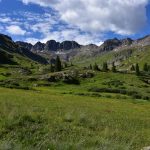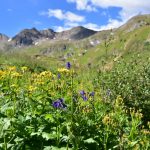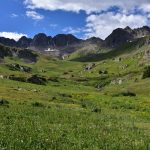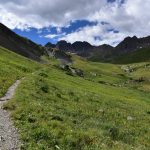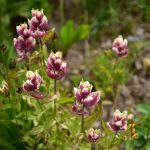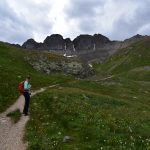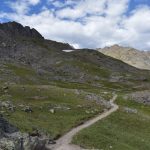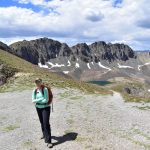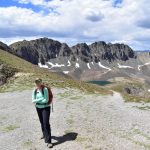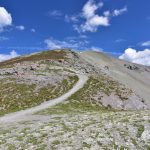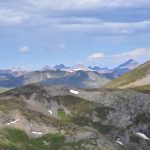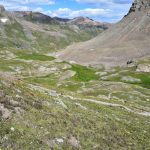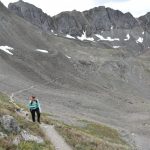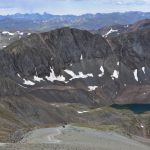Take a Walk
A Quest into the Wild
Pikes Peak via the Crags 14,115 feet
Posted on July 27, 2018 by admin
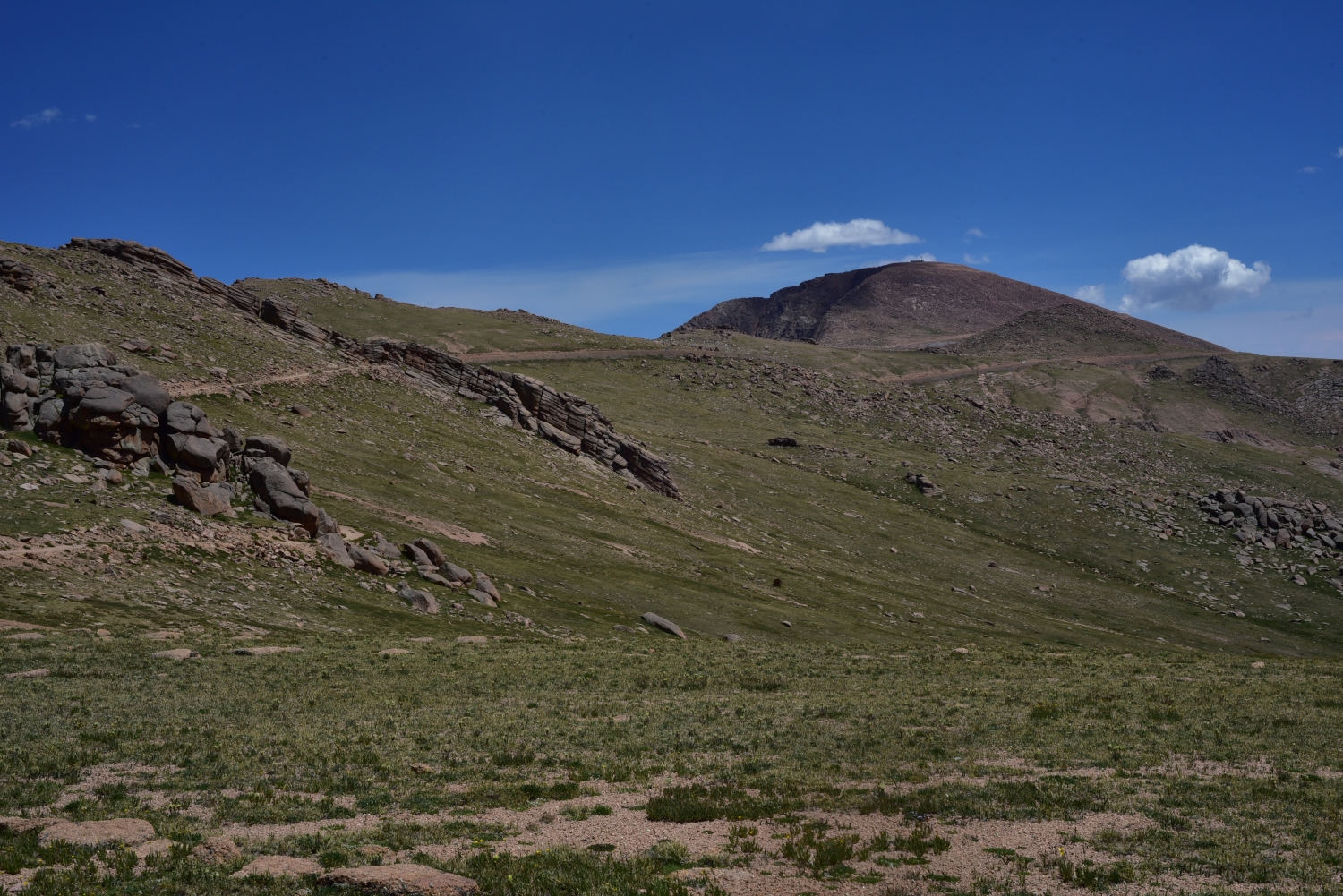
Data from the Garmin
Distance: 14.59 miles Net elevation gain: 4,418 ft Date of summit: 7/2/2018
It was the Sunday evening before the 4th of July, and we were itching for another 14er to summit though we weren’t particularly eager for a long drive or car camp the night before. In our peak “bagging” project, we only have Longs Peak and Pikes Peak left in the Front Range, and for some time have contemplated letting our 14er finisher be Pikes Peak so that family and friends can drive up and meet us at the top. Well plans change, and we figured this was the only reasonable peak to get in this time while allowing us a little more sleep in the comfort of our own home. Bright and early…or should we say dark and early on Monday July 2nd, we awoke and made the 2 hour drive to the Crags Campground TH for Pikes Peak.
For those of you familar with Pikes Peak, you’ve probably heard of the famous Barr Trail that leads 13 miles up to the summit with over 7,000 feet of elevation gain. This is the standard iconic route that most people take and usually involves an overnight stay at Barr Camp about half-way up the peak. However, there is an alternative for those seeking to gain the summit of Pikes without such a long slog. Less popular and less traveled is the Crags route, which begins near the Crags Campground located near Divide, Colorado. Round trip this route is a litte over 14 miles and gains roughly 4,100 feet of elevation. While still long, this route saves a lot of time compared to the standard 26 mile walk up. To reach the moderately sized parking lot and the start of the trail, we turned off of Colorado 67 near a ranch and drove for about 3 miles on a 2wd dirt road. The parking lot was nearly empty and there were vault toilets there as well. We began our ascent at about 7:20 am. Though we had hoped for an earlier start time, the distance to reach the Crags TH from our home in Denver took much longer than expected. Plus, one of us needed a coffee/breakfast stop on the way there.
We immediately crossed Fourmile creek on a nice bridge and began our trek through some dense forest. After about half a mile of moderately gaining elevation, we reached a trail junction. After reading trip reports, we were on the lookout for three “pipes” sticking out of the ground to mark the upcoming junction. We easily found the pipes but there were also nice signs indicating the junction. We followed the signs to Devil’s Playround towards the right. This portion of the hike was quiet, and peaceful. We passed two parties hiking up which always makes us feel great about our pace and accomplishment, however a trail runner later passed us quickly humbling us. The hike became much more interesting as the trees started to thin, opening up views of the exquisite valley below us. Close to 11,000 feet, we encountered a small meadow before ascending a steep hillside that exited the trees completely. Seen below are photos as began to leave treeline.
After ascending another steep hillside, we gained a ridge, and the trail leveled off a bit. This portion of the hike was very reminiscent of the Mount Flora hike off of Berthoud Pass for those familiar. This is the quintessential alpine environment that we seek so frequently. At the top of this slope, we were near 12,800 feet. We had gained close to 3,000 feet of elevation after about 3.5 miles. While beautiful, there were some steep sections in the first few miles of the Crags route. The trail widens here, and we followed it northeast towards Devil’s Playground and the Pikes Peak road. As we approached the “Playground” named for the frightening lighting storms that take place here frequently in summer afternoons, we came upon a large gap in a strip of rocks that we passed through to get to the Devil’s Playground parking lot. This entry point to the remaining route was quite dramatic. For our fellow Tolkien fans, we imagined Gandalf shouting “you shall not pass!” We passed though and were greeted with the first signs of civilization, and were reminded of why we have been putting off climbing Pikes Peak. Because of construction at the summit house, there is currently limited parking on the top of Pikes. Shuttle bus operators were asking people without kids or disabilities to park at Devil’s Playground and ride up with them to save parking. It was still relatively calm this early in the morning, and there were bathrooms which is rare for a 14er adventure above treeline. Nonetheless, the remaining route would be devoid of the privacy we were afforded in the first few miles.
We crossed the Pikes Peak Road for the first time at the Devils Playground parking lot. Hiking along the road is prohibited, and if you are caught then you are likely to get a ticket. Instead, the trail follows the road for a portion, which in our opinion is much preferable to hiking up concrete next to vehicles flying by. We were now about 2.25 miles from the summit, and the trail was gentle until the final push. There were a few more hiking parties that had joined the trail for the abbreviated version at Devil’s Playground, but most people we saw were boarding the shuttle busses for the top. We enjoyed the mild terrain as we got closer and closer to the summit. Seen below are photos.
The final push to the summit was much more entertaining than most of the hike. There was some easy class 2 scrambling fun as we picked our way up the remaining 500 feet. Once again we felt emersed in the wilderness as we hopped from boulder to boulder, the air feeling almost thinner we each new step. It was almost unnerving as we gained the summit and approached a large parking lot, hordes of people, and the summit gift shop and restaurant. Nonetheless, we knew what kind of trek Pikes Peak would be and embraced the opportunity to refill our water, buy a few gifts for nieces and nephews, and eat some of the famous donuts and a grade school cafeteria style cheeseburger. We spent about an hour on top, eating, shopping, and taking video and photos from America’s mountain. It was fun to see so many families of all ages together enjoying themselves at 14,110 feet. Or is it 14,115 feet…The summit sign states 14,115 feet, but through the years the elevation keeps getting changed. Originally measured 14,110 feet in 1929 and then there were some strange hundred feet increases from that when people tried to count the height of the summit house. When Congress adoped the “National Geodetic Vertical Datum of 1988” in 2002 and recalcuated peak measurements, it changed to 14,115. As far as we are concerned, it’s well over 14,000 feet but not close enough to contest the tallest peak in Colorado, Mount Elbert, so..who cares! Seen below are more summit photos.
It was noon now and time to go back down. The weather was perfect, with barely a cloud in sight, however we understand how quickly this can change in the alpine. We followed our path back through the boulder field and headed for the gateway to solitude once again at Devil’s Playground. And we do mean gateway. At around 1:00 pm, there were hordes of people. We estimated probably 100-15o people were in line to ride the shuttle to the summit. There were more people here than on the summit. It was very satisfying to just keep walking away from the crowds back to the alpine splendor, even if it meant we had another 5 miles to the car. Seen below is the “gong show” at the Playground and some views from the way back down. Of note, there were several mountain goats near the roadway on the way down. They stared us down intently as we hike down, and it was unsettling. We were a couple hundred feet away. Several cars coming up thought it was a great idea to pull up right next to them and shout at them from the windows which is not too cool.
As we began the steep descent to the car, we noticed several large plumes of smoke from nearby fires. There is not enough moisture this year, and fires are sadly burning all over the state. The descent proved more challenging than the ascent on the remaining trail. There were steep scree slopes that reminded us of hiking on a bunch of marbles. In fact, as we were resting and snacking near treeline, we encountered a member of the Colorado 14er’s Initiative. He had been scoping the trail all day and noting trail quality for future grants and improvement projects. He pointed out that many areas of the this trail were in need of modification, and overall the trail was in poor condition. The remaining hike was uneventful, and we reached the car at about 4:00 pm after about an 8 hour day on the trail. We thoroughly enjoyed the day and hike much more than we expected too. Prior to beginning this peak, we had some negative thoughts about the crowds and summit house and cars. But, it turned out to be a fun and unique high alpine experience. Not everyday do you get to enjoy a cafe on a summit.
We finished the day in Woodland Park enjoying dinner at the Ute Inn which was quite satisfying after a long day. Rather than battle traffic in the Springs, we opted to take a scenic route home on 67 through Deckers and along the Platte River. It was quite tranquil, but took us way longer than expected. A detour ended up leading us up a steep dirt road with hairpin turns. Despite the long adventurous drive back we were happy to be together and thankful for another great day climbing and hiking in this amazing place. We are now getting close to the halfway mark of the CO 14er peaks. Until next time….enjoy some more photographs from the day.
Mount Princeton 14,197 ft, Sawatch Range
Posted on June 12, 2018 by admin
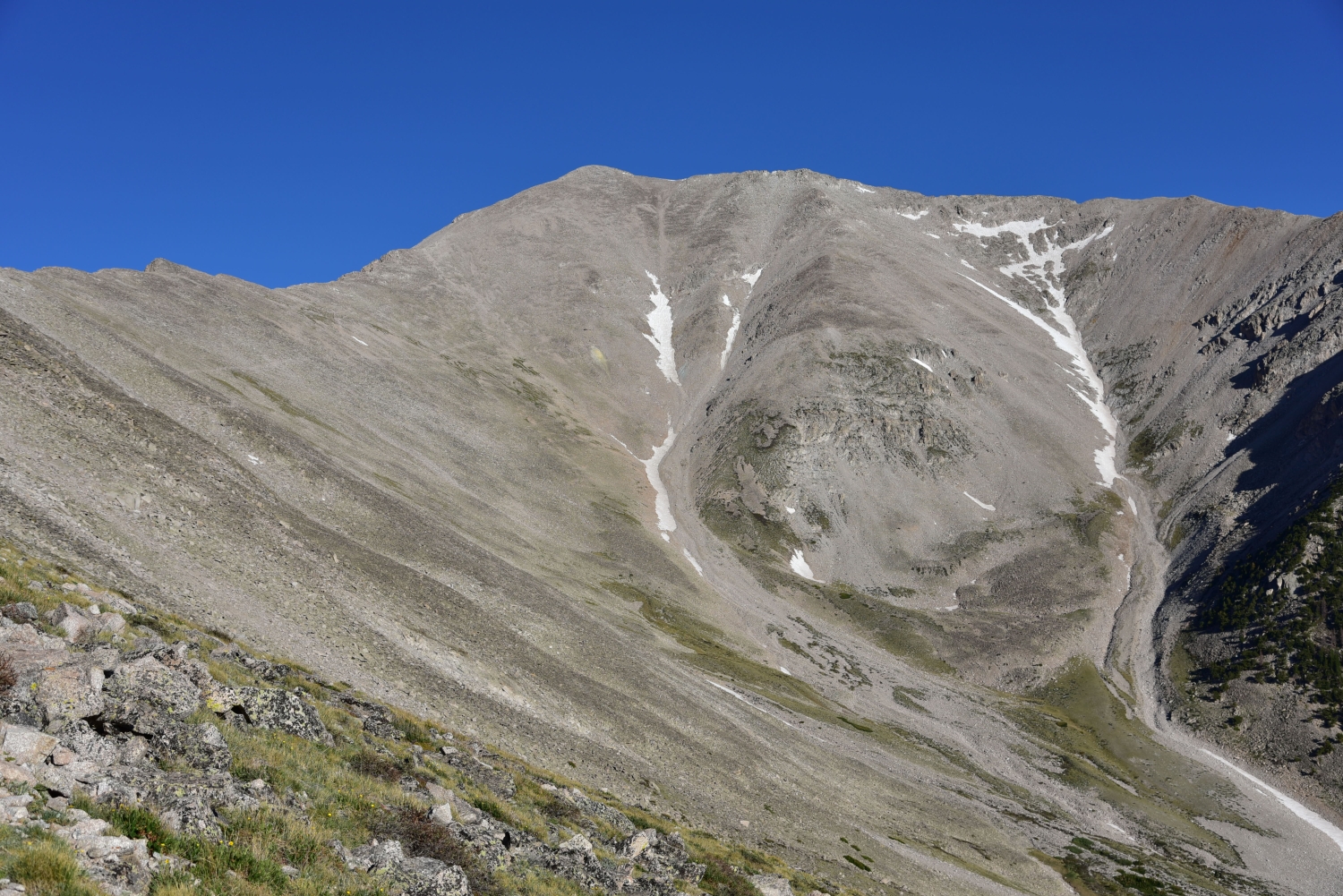
Though the hike up Mount Princeton will be described in better detail as we go along, the photographs above provides a fairly accurate summary of this mountain for those seeking to summit this summer. Talus hopping, navigating steep scree- filled slopes, and dodging the apparent infestation of spiders spinnning their intricate webs among the maze of rock were interwoven into our day. In between the scree surfing and selecting our next boulder step, we drank in the views of the bright blue sky above us and the exquisite alpine around us.
Mount Princeton is one of the Collegiate Peaks located in the Sawatch Range. It’s 14,197 feet above sea level and prominently sits above the small mountain town of Buena Vista. The lower TH is easy to get to, with a large parking area, but be warned, starting from here makes for a much longer, more strenuous day. Hikers will need to gain 5,400 feet of elevation and hike a total of 13.25 miles. We chose to take the X-terra with brand new all-terrain tires up the narrow 4WD road to reach the upper trailhead and camping spots located just past the radio towers. This reduced the gain and round-trip mileage to around 3,200 feet and 6.5 miles, respectively. Almost immediately, we encountered large dips and steeps gains along the road. However, the biggest challenge of the road is how narrow it is. There were several long stretches of the road in which there was no way for two-way traffic. We headed up around 4:30 pm on a Thursday afternoon hoping to not encounter any down hill traffic. Unfortunately, about half a mile up, three large suburbans/trucks were heading straight for us. While uphill traffic has the right of way, there was a small pull-out about 500 feet below, so we carefully backed down the road to let the others pass. The rest of the drive up was fairly uneventful, with the exception of some very large drop-offs as the path became a shelf road. It was slightly unnerving to have the truck lean slightly while skirting the edge of a cliff. Once we reached the radio towers, we continued on the road for another 0.2 miles and found a lovely campsite with room for our tent, two trees to tie our hammock, and spot for the truck. Seen below is a set-up of our camp, the radio towers, and wandering around the area prior to our hike the next day.
The temperatures were cool, but not cold as the sun began to set. We hiked up the road a bit further to enjoy the sun setting. Several spots had openings among the trees that offered views of the town below. As we hiked a little further, we also gained our first views of the summit of Mount Princeton. As it got dark, we retired for the evening. It was mostly a quiet night, with the exception of some strange noises at 3:00 am. At first, we thought it was the Colorado 14ers Initiative group perhaps working on something for the next morning. Their group was camping near us. However, as the noise got louder, it sounded as if it was coming from the car. We quickly flipped on the lantern, and made some noise, and the scrapping/grinding noise stopped. We never figured out what the noise came from, but we think some forest creature was attempting to get into our vehicle. At least this disturbance gave us a glimpse of the night sky. The inky black sky was dotted with a plethora of stars. The views were brilliant and such a amazing treat when coming from the city lights of Denver.
A short two hours later, the sun began to rise. It was time to get moving. All ready we could hear the few other hikers and CFI workers getting ready to start their day. We began our hike at 6:20 am. The morning temperatures were in the upper 40’s, but we quickly ditched our jackets as we made progress up the road. We continued to follow the 4WD road up for what seemed like close to a mile where we reached around 11,800 feet. As views of Tigger peak appeared, we began looking to our right for the trail turn-off for Mount Princeton. There is a large stone staircase that marks the start of the Mount Princeton Trail, and we didn’t have any trouble locating it. Online forums mentioned it can be easily passed by if snow is covering the steps or if you aren’t paying close attention. Missing the turnover will take hikers up the road to the top of “Tigger Peak” and then down the connecting ridge to Mount Princeton. This is the winter route to Princeton, and will add some distance and elevation gain to the day. Seen below are photos of the hike up the road and the turn-off to the Mount Princeton TH.
We were thankful to ditch the road and continue our journey on an actual trail, even if that trail became a talus field soon. We crossed the north side of “Tigger Peak” on relatively smooth trail for about a quarter of a mile until we reached the gullies. The trail crossed through mostly stable rock, and the elevation gain through here was modest. There was one remaining snowfield to cross when we summited on June 8th, but the section was well-boot packed and we had no trouble crossing. It was truly astonishing how little snow is left in the high country this early in the year, and also a bit concerning. As we hopped and skipped our way over boulders, we could see the remaining route in front of us and the summit of Mount Princeton. Compared to some of the other 14ers, we thought it honestly didn’t look too far away. Seen below are photos of the start of the Mount Princeton Trail and the fun gullies we had to cross. If you look closely, you can see the faint path through the gullies leading towards the summit.
Shortly past the snow drift, the trail veers left to gain the ridge. We followed the series of steep-switch backs up the ridge and were greeted with some cold wind, but also striking views of the nearby 14er, Mount Antero. We could still see some remaining snow hanging on to the nearby slopes. We paused for a moment on the ridge to enjoy the views before carefully picking our way along the talus ridge towards the summit. The terrain and elevation made the hike slow going once we gained the ridge. We were now above 13,000 feet for the first time in several months. Despite the heaviness in our legs and strain on our lungs we could see the summit, and it looked so close. We continued to weave through large spider-webs and subequently pass large spiders that looked to be Mountain Spiders (Aculepeira carbonarioides). They were out in the bright sun, basking. Seen below are views of Mount Antero from the ridge, and the slog up the steep rock leading to Princeton’s summit.
The final 900 feet (elevation gain) or so to the summit were tough. The trail turned to loose scree and dirt and was very steep. It took more energy to balance and gain elevation at the same time. Despite looking close by to us earlier, at this point, it seemed just out of reach with each additional step. At around 9:30 am, we finally topped out. The sky remained a perfect hue of blue and clear. We could see for miles in all directions. There were nice views of much of the Sawatch range including Mount Antero and Mount Yale and to our east we could see all of Buena Vista below. We took reprieve from the sudden gusts of wind in one of several rock shelters built on the summit for around half an hour. Seen below are photos from the Summit.
Interestingly, the descent from Princeton’s summit was not as fast as normal. The loose dirt and scree and series of boulder hopping across the gullies made for slow going for most of the journey back to the road. We took our time and ensured good footing, and also admired much of the alpine flora. It’s always amazing to see the brilliant display of flowers that manage to survive the harsh conditions of this environment. Seen below are a view of the many varieties that dotted the grassy slopes and the crevices between rocks on our descent.
We reached our camp around 12:30-1:00, roughly 6 hours after we began. Though this hike can be done much faster, we took our time with footing and let ourselves adjust to the workload at high altitude since we haven’t been to 14,000 feet in a while. As we drove back down the 4WD road to the lower parking lot we had the road to ourselves, which was very nice. We stopped by the Mt. Princeton Hot Springs Resort — only a few miles from the trailhead — and had a nice lunch. It was far too hot to want to soak in hot springs for us, but we did walk the grounds, and we want to come back when the weather is cooler.
It was a quick drive back to highway 285 and as we passed Johnson Village we stopped briefly to look back at what we had just done. Even from miles away, Mt. Princeton stood prominently over the entire range. We could make out the trail to the summit and see the small snow field we crossed. Shavano, Antero, Princeton, Yale, Columbia, and Harvard were all in view (see below). It was a humbling end to a great trip and we look forward to coming back for more adventures.

Mount Yale Sawatch Range, 14,196 feet
Posted on October 10, 2017 by admin
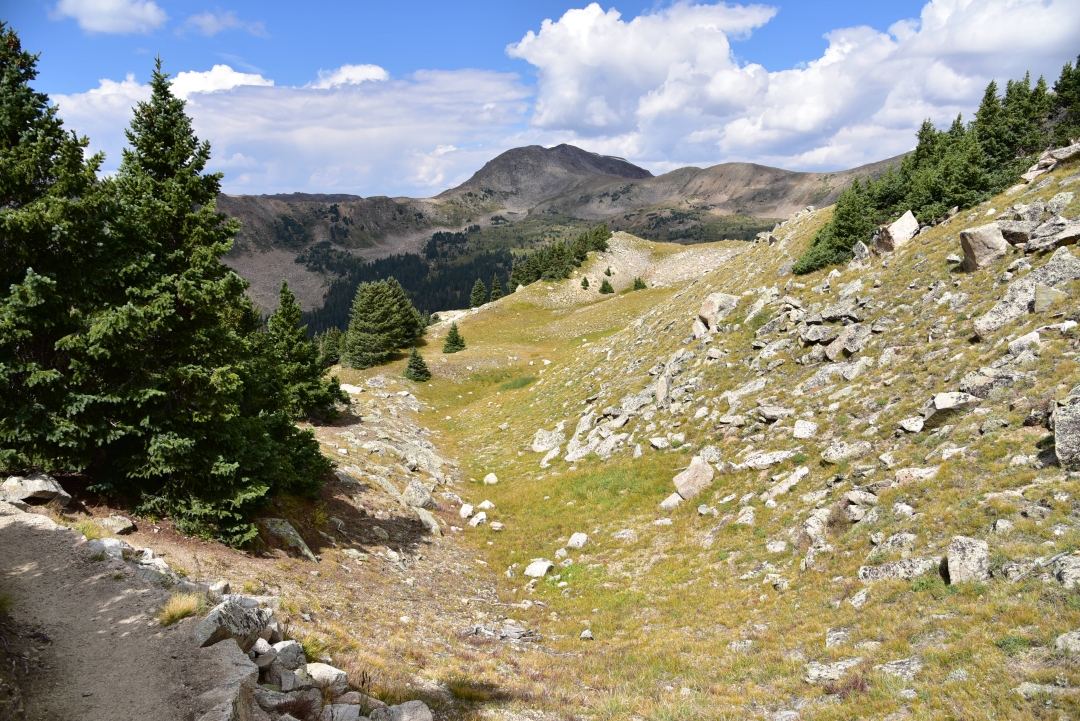
It’s currently October 9th and already a fresh blanket of snow has fallen on the front range. Though not the typical dry fluffy snow of later in the season, the wet slushy puddles have definitely reminded us that the warm summer months are gone. As such, we reflect back on our last snow-free 14er of the season, Mount Yale which we climbed exactly one month ago from today. Mount Yale is another one of the gentle Sawatch Range giants nestled in the Collegiate Peaks just west of the Buena Vista. When we say gentle, we simply mean a lack of technicality to the climb. In no means was the peak gentle in distance and elevation gain. The trailhead to the peak is located just right off of Cottonwood Pass. A short 12 mile or so drive on a smooth paved road leads to a smooth paved parking lot and easy access to adventure. Nonetheless, the long distance of TH from the Denver metro area required an overnight camp in the nearby Collegiate Peaks Campground. Despite sleep deprivation and a large workload in the days proceeding, we shrugged off our exhaustion, drove to our destination, and set up camp just before the sun set. The moon remained bright this night. Once our eyes adjusted to the darkness of the night, we could actually see quite well. We hunkered down for what we thought would be a cold night, but to our surprise, the early fall weather did not make us suffer. Even at over 9,000 feet, temperatures did not drop below 48 or 49 degrees F. Throughout the night, there was the occassional rustle of the leaves and perhaps a mouse or two seeking shelter near our tent, but otherwise relatively quiet. When the sun rose, we reluctantly crawled out of our shelter and drove the half mile down the road to the TH.
Though not completely full at 6:30 in the morning, the parking lot did have several other hikers prepping for their summit attempts. September truly can be one of the most spectacular times of year to hike and climb in Colorado. The crowds near popular THs are reduced, the fall foliage exudes color in every direction and the crispness in the air puts a bit of urgency in the step. Thunderstorms are less common, but snow and ice are known to commonly appear, particularly when one is close to the summit enjoying lunch or any other such activities. We started the climb about 7:00 am. The initial grade of the trail was mild and enjoyable. The aspen and lodgepole pine forest provided a cool canopy. The sounds of the Delaney Creek could be heard as we wove through the forest. About a mile into our hike, we crossed the creek over a log bridge (the first of many crossings it would seem). Shortly after we reached a trail junction. Head left for Browns Pass/Hartenstein Lake and right for Mt. Yale. Seen below are photos from the beginning our our hike.
There were several flat areas of the initial portion of the hike which had us a bit concerned for the work load that was ahead. Just as we began to think we might actually be getting off easy, we reached a series of brutal switchbacks near 11,200 feet. We followed the steep trail up the hillside through more and more trees and thought that we would never reach treeline. Several hiking parties were passed during this time, and we kept our quick pace if only to avoid the constant leap frogging that can occur when sharing the trail. Everything was still so green and beautiful on this great trail. Seen below are photographs before we completely left the trees and green vegetation above 12,000 feet.
Aftering leaving the trees, we headed northeast toward Yale’s upper west slopes. Much of the remaining route was visible to us now. We followed a gentle trail on the shoulder of the mountain for a while soaking in the surrounding grandeur. A large boulder provided a brief break, as we snacked on a childhood favorite, pop-tarts. The gas station attendent the previous night had given us a hard time for our purchase of pop-tarts and barbeque potatoe chips. It was perfect on the mountainside this day. Near 13, 200 feet, a steep trail greeted us. We had nearly 800 feet to climb up in a very short distance to reach the ridge and final section to the summit. Nearly everyone we saw heading up this portion appeared to be on the struggle bus. It was a tough bit of work and the spot in which our exhaustion from the previous week began to really show. Seen below are photos of the shoulder of the mountain and struggle up the ridge.
Once on the ridge, the trail to the summit disappears. There is several class 2 rock to navigate, and many places where the route can venture into difficult class 2 if chosen. It was much more fun and interesting than the rest of the hike, and we forgot for a while that we were tired and almost at 14,000 feet. We scrambled gleefully along the ridgecrest, primarily sticking to the right side. Several cairns were placed along the route to provide gentle guidance. They led the correct way for the most part. It only took about 15 minutes to reach the summit once we were on the ridgecrest. The summit is not really the most comfortable summit compared to the rest of the 14er tops we have visited. Jagged rocks protrude everywhere. Several other hiking parties were on the summit or got there shortly after us, and navigating around the rock was even more difficult dodging other people. We took a few photos, but spent very little time here. The clouds that were building caused a big drop in the temperature, and we needed to get moving.
As we carefully downclimbed the ridgecrest, the sleet began. It was cold and sharp to the skin, but was not heavy enough to affect our visibility. We were very thankful for this rather than a thunderstorm. Nonetheless, we moved very quickly because we still weren’t sure that a thunderstorm wouldn’t also move this way. As we reached treeline, the weather cleared for a while. Once again we were greeted with endless blue skies and greenery. On the way down, we stopped next to a hidden creek and small waterfall for lunch which consisted of bbq chips and chicken jerky. The trail seemed longer on the way down than on the way up as it always seems to. With about 1.5 miles left in the journey, it began to rain. For the first time in the life of our hiking packs, we were able to utilize our cool pack rain covers. Sometimes it’s the little things in life like the joy of using a neat feature on a day pack or the feel of the grip of hiking boots on smooth granite that add to our great experience in the backcountry. In the distance, we heard thunder and hoped that all the people continuing up the peak were okay. Shortly thereafter, we reached the truck. In total we hiked/climbed approximately 9.5 miles and gained a total of 4,300 feet. The Sawatch Range has 15 named/ranked peaks above 14,000 feet. After our summit of Mount Yale, we have now climbed 9 of them. While Yale wasn’t our favorite of this range (Mount of the Holy Cross is hard to beat here), it was certainly beautiful and well worth the journey. Seen below is a gallery highlighting the rest of the day and hike.
Handies Peak, San Juan Range (14,048 ft)
Posted on September 25, 2017 by admin
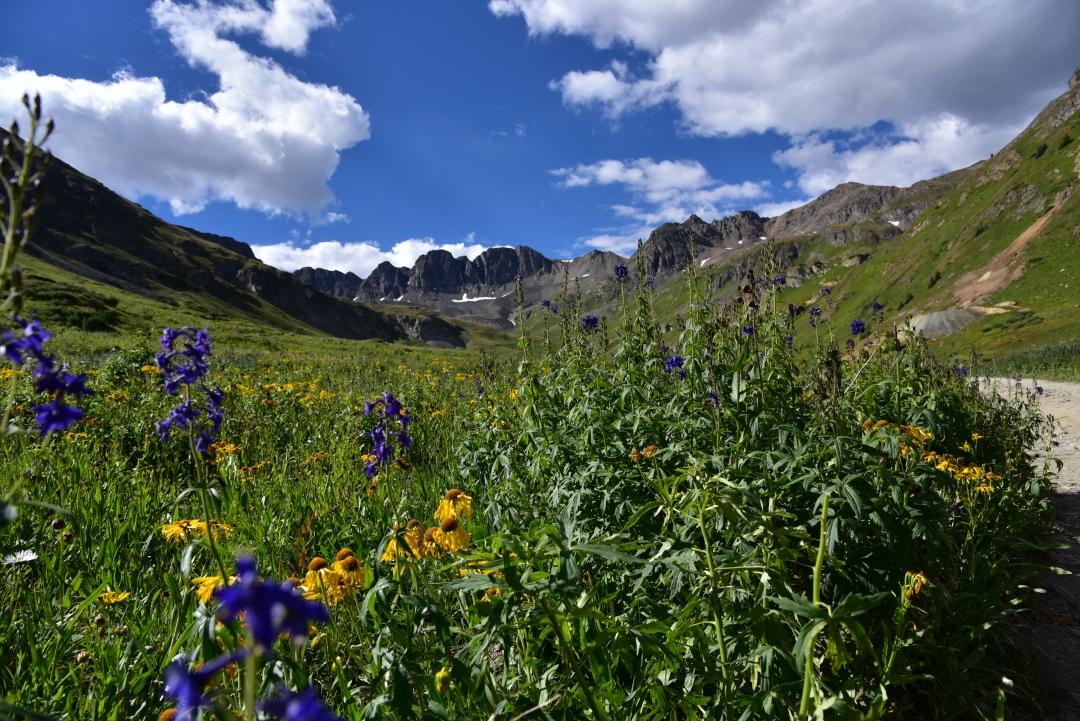
As part of our trip to Lake City in late August, we also reached the summit of 14er Handies Peak via the stunning American Basin. This time, we opted to leave a bit later in the morning in our summit attempt, as the route up Handies via American Basin is a much shorter, class I jaunt. Plus, our exciting class III scramble up Wetterhorn the previous day had left us a little bit exhausted. We left our Cabin in the light of morning this time, and set out on the Scenic Alpine loop to reach the trailhead. Per the detailed instructions on 14ers.com, we followed the road past San Cristibol Lake and then took the fork towards Cinnamon Pass. We had no idea that the adventure was going to actually start there, up that steep rocky road. We quickly gained elevation when the road forked. Dirt-bikes and ATVs flew past us, seemingly unnerved. If our ride were a bit smaller, I’m sure our confidence would have been just as high, but we were in the X-terra. As the elevation gain ceased, we realized that we were on a narrow, shelf road. Thankfully our current direction of travel allowed us to hug the side of the cliff, but the sheer drop offs on the left still left us tense. We prayed that another car would not turn the blind corners during this stretch. After a mile or so of intense sketchiness, the 4WD became more tame. Our truck now easily bumped along, passing the RedCloud and Sunshine 14er THs before getting closer to American Basin. We continued along this easier portion of the road for another 9 miles or so until the road forked to Cinnamon Pass on the right, and American Basin on the left. The truck took us about halfway to the upper 4Wd parking lot. At this point, we were incredibly anxious to get out of the vehicle. The magnitude of American Basin’s beauty mesmerized us, and we wanted to hike in this spectacular place as soon as possible.
Even though it was late August, there was still a number of wildflowers in bloom in every color imaginable. We soaked in all the brilliant colors, as we hiked about half a mile to the upper parking lot and official start of the trail. From here, the total elevation gain is only 2,500 feet in a round trip of 5.5 miles. The trail steadily gains elevation here among throngs of flowers, almost as tall as we are. Looking ahead, we were provided impressive views of the jagged ridgeline in this glacial carved basin. The incredible scenery was enjoyed in almost solitude. Despite, it being a Saturday on an easier 14er, the trail was generally empty.
Aside from the outstanding beauty from the very second you reach American Basin, the first spectacular objective to see on this hike is Sloan Lake. After just 1.5 miles, a short social trail appears on the right that leads to the banks of this alpine wonder. We took a quick break at the banks of the deep, dark blue water to eat a snack and relax. This is truly, one of the most amazing places in Colorado we have ever been. All of the views were so dramatic. Standing on the banks of the dark expansive pool, we felt so small. The jagged granite towered above us. It was time to continue to the summit. Most of the remaining route was visible now, in the form of a faint line of switch backs drawn across the side the mountain. On other days, this would have been an easy ascent, but our legs were heavy from Wetterhorn. The remaining route felt physically hard, even though this is considered one of the easiest 14ers in Colorado.
The higher we climbed, the looser the trail became. The final push to the summit was very steep and full of scree just waiting for us to make a mistake and slip. The lack of available oxygen to breathe was more apparent today than the previous day. Never did we anticipate that reaching such an easy summit would bring us such joy. We could now rest our legs for a while and soak in all the beauty. We shared this popular summit with just two other hikers for a few minutes in the late morning, and even had it to ourselves for a bit. The panoramic view from the summit included the Grenadiers and Needles Mountains to the Southwest and Wetterhorn and Uncompahgre Peaks to the North. Seen below are photos from the top of Handies.
Rained looked inevitable, so we decided it was time to descend. The climb down was a bit difficult until the scree mellowed out closer to Sloan Lake. Once to the lake, we made quick work of the hike back to the car. When we reached the upper 4WD parking lot, we realized the rain clouds were just teasing us. The sky once again returned to a perfect blue, a perfect accent to the emerald green expanse of the valley below. When we reached our truck, a group of fellow hikers were nearby and offered us some of their watermelon, which turned out to be probably the tastiest watermelon we have ever had the opportunity to eat. There is nothing quite as satisfying as the crisp, coldness of this sweet fruit after 7,000 feet of elevation gain in two days. Though it was tempting to stay in the beautiful basin for longer, we needed to start the long 20 miles back to Lake City. We still had the scary shelf road to travel on before we could breathe a sigh of relief and feel truly accomplished. To our surprise, the road was much more crowded in the early afternoon. Several ATVs and other vehicles shared the road with us. As expected, the shelf road was intense, though not as bad as it seemed on the way up in the morning. There is some benefit to knowing what to expect to help ease the nerves. In fact, we even filmed it this time which can be viewed via this link. We reached Lake City in time for a delicious dinner at none other than the Cannibal Grill and Packer Saloon. (we got salad and pasta…). Another outstanding day in the San Juan mountains was complete.
Categories
- 13er (9)
- Class 3 (1)
- 14er (26)
- Beach (2)
- Difficulty (69)
- Difficult (19)
- Easiest (6)
- Easy (23)
- Intermediate (26)
- Most Difficult (1)
- Dirt Biking (1)
- Foothills (7)
- Guest Blog (2)
- Interview (1)
- Jeeping (1)
- Plains (3)
- Rafting (1)
- Rocky Mountains (49)
- Uncategorized (3)
Search
Copyright © 2024 · All Rights Reserved · Take a Walk
Theme: Natural Lite by Organic Themes · RSS Feed
